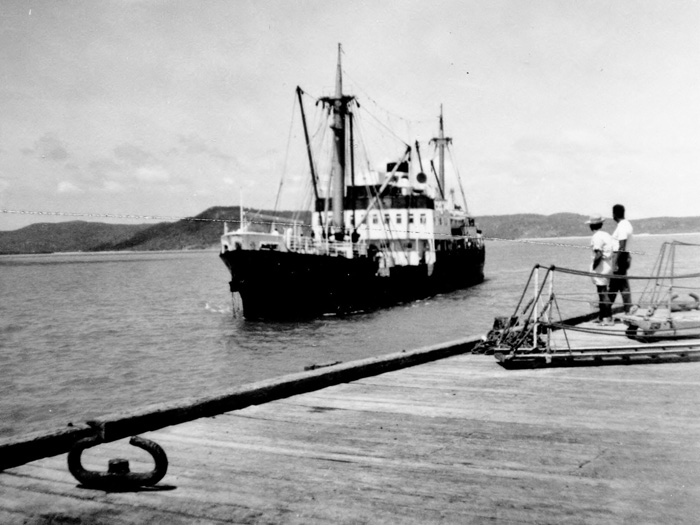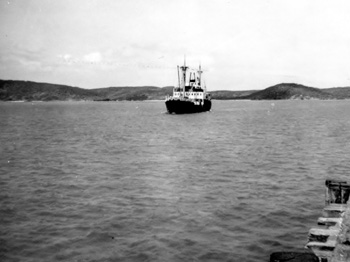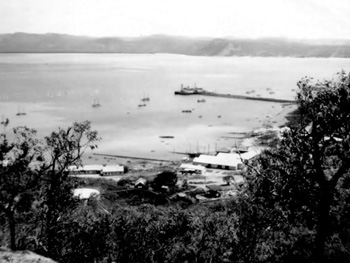M. V. Waiben
Cargo & Passenger Ship
(Formerly MV Morialta)
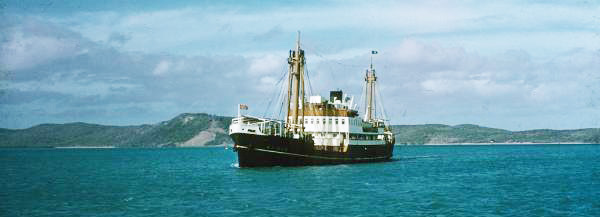 |
M. V. Waiben in Thursday Island harbour - 1959 - with Prince of Wales Island in the background. (Lionel Bevis) |
This page is about the John Burke Ltd ship M.V. Waiben - a coastal cargo and passenger ship that operated between Brisbane and Thursday Island, Queensland, Australia from 1957 to 1964. It was the former M. V. Morialta. This ship should not be confused with the Queensland Government Pilot Launch Waiben that operated at Thursday Island from 1949 to 1977; nor the modern 6.2 knot 13 x 4 m pleasure cruiser Waiben that calls Brisbane home.
 |
By Dr Richard Walding, Research Fellow, Son of Robert Walding, Electrical Engineer, MV Waiben 1961-1963. If you have additional information or comments about the photos in this webpage please contact me. |
THE MORIALTA - BEFORE SHE BECAME THE WAIBEN
In 1938, the Adelaide Steamship Co. decided they needed a new ship for the South Australian coastal run. They ordered a new 1,365-ton diesel-engined passenger-cargo ship, to be named the Morialta, from Caledon Shipbuilding and Engineering Co. in Dundee, Scotland (Contract No. 168004) - at a price of £117,250. Her dimensions were 219'5" x 39'1" x 13' and she was a steel single screw motorship. In Sept 1939 the Adelaide Steamships Co.sent one of its most experienced master mariners, Captain Dick Tobin, aged 47, from Adelaide to Dundee to supervise the construction, and to bring her home. But on its completion the Morialta was requisitioned by the British Ministry of War Transport for Troop Service and heavily armed as a naval auxiliary, commonly known as a Defensively Armed Merchant Ship (DEMS). The Adelaide Steamship Company should have been inured to such a request: they had 30 or so ships in South Australia and the majority were requisitioned by the Royal Australian Navy for war work. For example, the Morialta's much larger sister ship Bungaree was built as a cargo vessel for the the company also by Caledon Shipbuilding & Engineering Company and launched in 1937. The ship operated in Australian waters and was requisitioned by the RAN in October 1940 and was commissioned into the RAN on 9 June 1941 after being converted into a minelayer. She ended her days in January 1973 where she capsized in the shallow waters of Mekong Delta Bay during a run from Phnom Penh to Vung Tau.
The Morialta was launched from the Dundee slipway on 7th May 1940 by Mrs Amy Vera Filmer (nee Booth) wife of the London manager of the Adelaide Steamship Company - Captain Charles Bruce Long Filmer. Amy Booth had married the Captain Filmer DSO (a Merchant Seaman) in Sydney in 1923 and the couple left for England for Capt. Filmer to take up his position with the Adelaide Steamship Co. They did not to return to Australia for 11 years, and then just for a holiday.
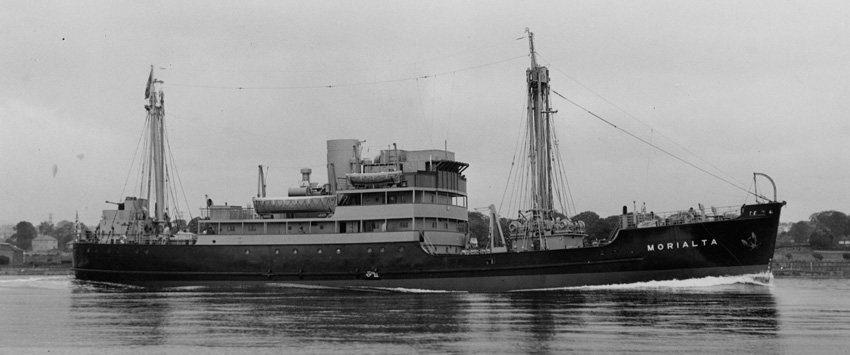 |
The Morialta in 1940 just after her launch and being defensively armed. |
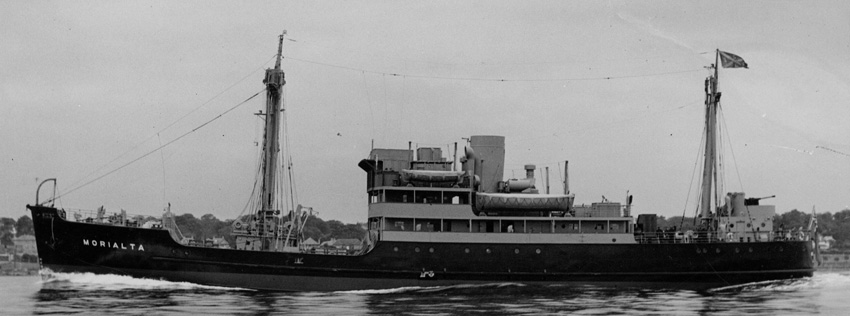 |
Another view of the Morialta after being fitted out with guns prior to her war service in 1940. [Dundee City Archives] |
WAR SERVICE
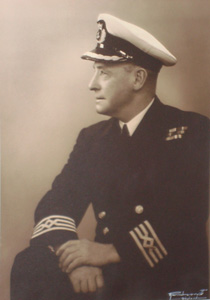 |
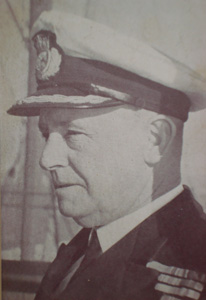 |
Captain Dick Tobin - MV Morialta (Ashleigh Tobin) |
|
Capt. Dick Bishop Tobin had became caught up in the war and would become a reluctant hero. He was given command of this brand new ship, not even off its stocks at Dundee. He would not see his family again for 6 years, including his 5½ year old son he had never met. Tobin was born in 1892 in Adelaide, son of Richard and Annie Tobin. In 1927 Tobin married Winifred Hambridge in Adelaide and he became one of South Australia most respected master mariners. Little did he know that his trip to Dundee to supervise the building of the Morialta was to get dangerous - very quickly.
In 1940, the British Ministry of War Transport (MOWT) requisitioned the Morialta for troop service and fitted her out with a heavy Oerlikon gun to be manned by army or naval gunners. But crew members from merchant ships -including the Morialta - were trained to operate light machine guns. As a DEMS she was equipped with degaussing coils laid on her deck. With large electrical currents running through them the chance of detonating magnetic mines (either enemy or friendly) was reduced. Her first deployment was on the Pentland Ferry service from Scrabster to Stromness in Northern Scotland with the Orkney and Shetland Steam Navigation Co., Ltd., Aberdeen as Acting Managers. Her task was to ferry soldiers and seamen from the mainland at Scrabster (near Thurso on the north eastern tip of Scotland) over to the Royal Navy fleet base at Scapa Flow.
On the 21st of February 1941, the Morialta under the command of Dick Tobin joined a flotilla comprising HMS Queen Emma, Princess Beatrix and a naval escort of 5 destroyers, and left Scapa Flow in the Orkney Islands. The destination was the Faroe Islands for final training. The primary targets were Norwegian fish oil factories on Lofoten Island. Their destruction would be a blow to German glycerine production needed as raw material for explosive production. In all, 11 factories and 5 ships were destroyed, 225 Germans and 60 Quislings taken prisoner and 314 volunteers given passage to UK based Norwegian forces. There were no losses. Morialta took German prisoners away.
On Sunday, 7th June 1942, His Majesty King George VI visited the Home Fleet at their base at Scapa Flow in the Orkney Islands where the US Task Force were visiting. He inspected an American cruiser accompanied by Rear Admiral Robert C. Giffen, Commander of the US Task Force and took a barge over to USS Washington at the invitation of Admiral Harold R. Stark, Commander, Naval Forces, Europe, who had made her his temporary flagship. The following day - Monday, 8th June 1942 - the King visited (British) Destroyer Command in the morning. He boarded HMS Tyne at 11.30 am and inspected representatives from destroyers and from the Depot Ship. He landed at 12.30 pm to visit the Orkney Command. The King proceeded from Scapa to Scrabster in M. V. Morialta at 6 pm escorted by HMS Wainwright, Ledbury, and Wilton (see below).
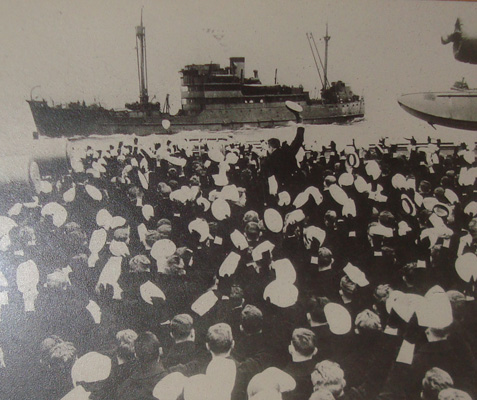 |
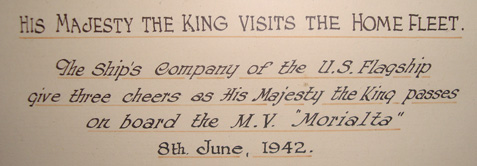 |
| Dick Tobin was Captain of the Morialta when the King visited. (Ashleigh Tobin) |
This event was reported in The Times (11 June 1942, p 6) as follows: "At the end of his visit, the King paid a tribute to the Merchant Navy by sailing through the fleet in a merchant auxiliary vessel and reviewing the British and American warships from the bridge of a small steamer [the Morialta] built for coastwise trade in Australia. A British and an American destroyer shared the honour of escort duty, and the C.-in-C., Home Fleet, stood at the King's side on the merchantman's bridge. From this small ship came the royal signal, 'Splice the main brace', the first time in history that this signal has ever been made from a ship flying the 'Red Duster' (merchantman)." [Note: 'Splice the mainbrace' is an order given aboard naval vessels to issue the crew with a drink. Originally an order for one of the almost impossible emergency repair jobs aboard a sailing ship, it became a euphemism for authorized celebratory drinking afterward, and then the name of an order to grant the crew an extra ration of rum or grog.]
 |
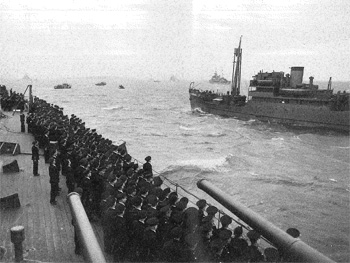 |
His Majesty the King was aboard the Morialta (pictured) inspecting the Home Fleet - 8th June 1942 |
Dick Tobin was the Captain of the Morialta during the King's visit. |
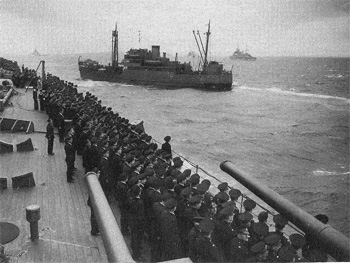 |
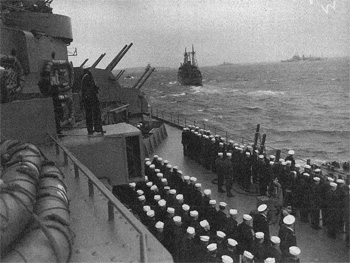 |
The Home Fleet was at Scapa Flow for the visit. The Morialta is shown in the centre. |
These four photos courtesy of Ashleigh Tobin, son of Captain Dick Tobin. |
When he left the fleet, on his way home, the King sent this signal to Admiral Sir John Tovey: "I am very glad to have had another opportunity of visiting the fleet under your command. I have been greatly impressed by what I have seen, and congratulate all ranks upon the keen and efficient manner in which they continue to carry out their duties, worthily maintaining the great tradition of the Royal Navy. To those of your officers and men now on patrol I ask you to send my good wishes. I am sorry not to have seen them. The best of luck to you all. - G. R. I." G.R.I. stands for "Georgius Rex Imperator" - George, King and Emperor.
For 3½ years Capt. Tobin sailed the Morialta around the North Sea carrying troops and cargo. On two ocassions she joined convoys for safety: EC90 departing Dundee on 28 October 1941 arriving at Scapa Flow the following day; and then WN328 departing Scrabster 27 August 1942 arriving Dundee two days later; and EN152 departing Aberdeen on 20 October 1942 to Lyness in the Orkneys (Scapa Flow) - a one-day journey. When not in convoy she was carrying out her Scapa Flow ferry service. By 1943 she was ready for a refit to prepare her for service in the Mediterannean - and returned to Dundee to have this carried out.

M.V. Morialta
In 1943 Morialta returned to Dundee for refit and was then sent back to Scapa Flow (North of Scotland) for various duties. In 1944 she was
transferred to the Mediterranean theatre where she took part in the landings in the South of France in September. On her way back to Marseilles from Oran she was mined and then towed to Alexandria where she was repaired - which took until June 1945.
One of the crew members who joined the Morialta during the repairs was Ordinary Seaman Arthur Norris, now residing in Queensland, Australia. He joined the ship in early May 1945 and stayed with her until war's end. Here is his story of his time aboard:
 |
Ordinary Seaman Arthur Norris |
A day or two after VE Day Joan (my wife) saw me off at Victoria rail station on the boat train to Paris and Marseilles where I joined the MV Morialta, which was really more, like a large motor yacht with limited cargo space and a number of cabins for guests or passengers. When myself and other crewmembers arrived at the ship we found there had been some breakdown in communication and that we could not board. The ship was Australian owned and had some time earlier been mined and run aground somewhere. Following repairs and refit the General Steam Navigation Company of London, who sent the crew out from London, managed it. |
MORIALTA'S CONVOYS
Departure |
Convoy |
Arrival |
| Dundee, Oct 28, 1941 | EC.90 (Southend - Clyde) | Scapa Flow, Oct 29, 1941 |
| Scrabster, Aug 27, 1942 | WN.328 (Loch Ewe - Methil) | Dundee, Aug 29, 1942 |
| Aberdeen, Oct 20, 1942 | EN.152 (Methil - Loch Ewe) | Lyness, Oct 21, 1942 |
| Milford Haven, Mar 19, 1944 | KX.15 (M Haven - Gibraltar) | Gibraltar, Mar 28, 1944 |
| Gibraltar, Mar 30, 1944 | UGS.36 (Hampton Rds - Port Said) | Augusta, Apr 5, 1944 |
| Augusta, Apr 7, 1944 | VN.32 (Augusta - Naples) | Naples, Apr 8, 1944 |
| Naples, Apr 12, 1944 | NV.32 (Naples - Augusta) | Messina, Apr 13, 1944 |
| Augusta, Apr 19, 1944 | GUS.37 (Port Said - Hampton Rds) | Algiers, Apr 23, 1944 |
| Algiers, Apr 27, 1944 | KMS.48 (Gibraltar - Port Said) | Augusta, May 1, 1944 |
| Augusta, May 1, 1944 | AH.40 (Augusta - Bari) | Barletta, May 3, 1944 |
| Augusta, May 11, 1944 | KMS.49 (Gibraltar - Port Said) | Port Said, May 16, 1944 |
| Augusta, Jun 14, 1944 | MKS.52 (Port Said - Gibraltar) | - |
| nilAugusta, Jun 16, 1944 | VN.47 (Augusta - Naples) | Naples, Jun 17, 1944 |
| - | MKS.52 (Port Said - Gibraltar) | Gibraltar, Jun 20, 1944 |
| Naples, Jun 26, 1944 | NV.48 (Naples - Augusta) | Augusta, Jun 27, 1944 |
| Augusta, Jun 28, 1944 | KMS.54 (Gibraltar - Port Said) | Alexandria, Jul 2, 1944 |
| Alexandria, Jul 9, 1944 | MKS.55 (Port Said - Gibraltar) | Augusta, Jul 14, 1944 |
| Augusta, Jul 16, 1944 | AH.55 (Augusta - Bari) | Barletta, Jul 18, 1944 |
| Bari, Jul 22, 1944 | HA.56 (Bari - Augusta) | Augusta, Jul 24, 1944 |
| Augusta, Jul 24, 1944 | UGS.47 (Hampton Rds - Port Said) | Alexandria, Jul 29, 1944 |
| Port Said, Aug 7, 1944 | MKS.58 (Port Said - Gibraltar) | Augusta, Aug 12, 1944 |
| Augusta, Aug 16, 1944 | VN.59 (Augusta - Naples) | Naples, Aug 17, 1944 |
| - | MKS.52 (Port Said - Gibraltar) | Gibraltar, Jun 20, 1944 |
| Naples, Jun 26, 1944 | NV.48 (Naples - Augusta) | Augusta, Jun 27, 1944 |
| Augusta, Jun 28, 1944 | KMS.54 (Gibraltar - Port Said) | Alexandria, Jul 2, 1944 |
| Alexandria, Jul 9, 1944 | MKS.55 (Port Said - Gibraltar) | Augusta, Jul 14, 1944 |
| Augusta, Jul 16, 1944 | AH.55 (Augusta - Bari) | Barletta, Jul 18, 1944 |
| Bari, Jul 22, 1944 | HA.56 (Bari - Augusta) | Augusta, Jul 24, 1944 |
| Augusta, Jul 24, 1944 | UGS.47 (Hampton Rds - Port Said) | Alexandria, Jul 29, 1944 |
| Port Said, Aug 7, 1944 | MKS.58 (Port Said - Gibraltar) | Augusta, Aug 12, 1944 |
| Augusta, Aug 16, 1944 | VN.59 (Augusta - Naples) | Naples, Aug 17, 1944 |
| Naples, Aug 22, 1944 | SM.4 (Naples - S France) | |
| Algiers, Sep 5, 1944 | MKS.60 (Port Said - Gibraltar) | Oran, Sep 6, 1944 |
ORDINARY SEAMAN ALFRED THAIN
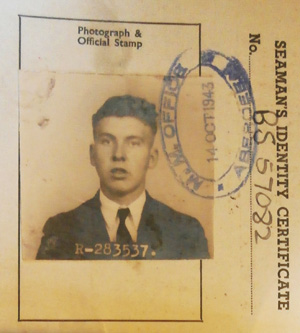 |
Ordinary Seaman Alfred Thain RN, 1943. |
One of the many seamen who served on the Morialta during the war years was Ordinary Seaman Alfred Thain, who as a Royal Navy crewman during the war years from 20th February 1944 (Dundee) to 24th February 1945 (Marsailles).
On 19 October 1943 Alfred was stationed at Dundee while the Morialta was being refitted, and was then sent back to Scapa Flow (North of Scotland) for various duties. On 20 February 1944 Alfred joined the crew of the Morialta at Dundee and headed for the Mediterranean where she took part in the landings in the South of France in September. On her way back to Marseilles from Oran she was mined and then towed to Alexandria to be repaired. Alfred left the Morialta at Marsailles on 24 February 1945.
 |
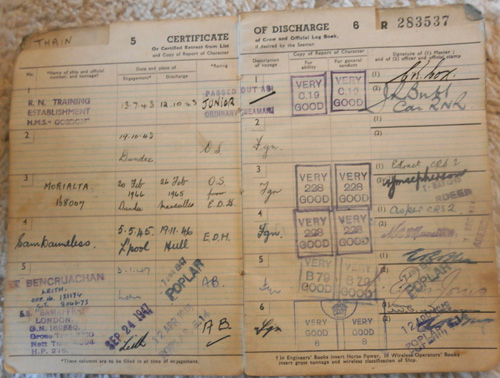 |
| Shore leave pass from the Morialta - Suez Canal - May 1944 | Alfred Thain's Continuous Certificate of Discharge from the Morialta. (Mark Thain) |
AFTER THE WAR
After the war - in 1946 - the Morialta left Alexandria for Colombo and Singapore where she was employed dumping explosives. The Adelaide Steamship Company did not see its new ship May 1st 1946 where she arrived in Adelaide from Penang, 5½ yrs after leaving builders yard. She was refitted for her original purpose, registered in Melbourne, and entered the South Australian Spencer Gulf passenger trade and cargo service.
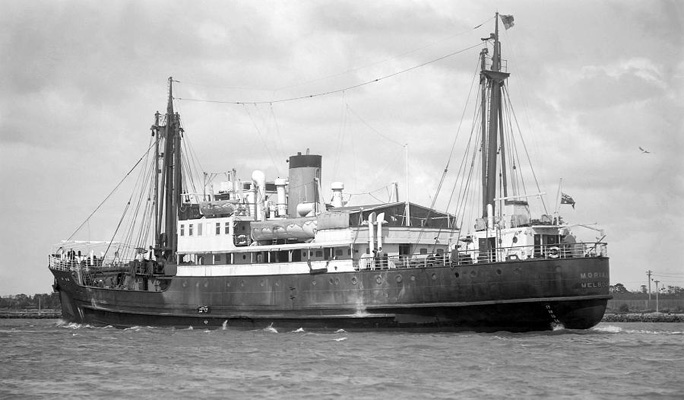 |
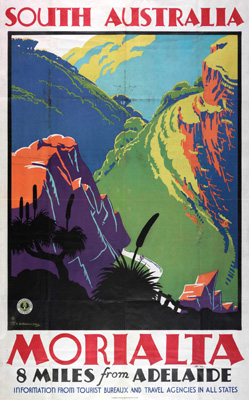 |
The Morialta typically left Port Adelaide on a Tuesday and visited Tumby Bay, Port Neill, Arno Bay, Wallaroo, Cowell and Whyalla. The 4-day cruise cost about £9. |
Poster from the 1950s
|
Donald Stuart Ross
One of the crew members aboard the Morialta during her Adelaide years was Donald Stuart Ross who served from 1953-55. His son Gordy Ross transcribed his father's ship discharges to show what a varied career a seaman has. Gordy, also a seaman, recalls going aboard the Morialta with his father and also sailed with Seaman Dick Danielsen (see Morialta crew list below). A full list of the ships Donald Stuart Ross served aboard can be found here.
In 1957 The Adelaide Steamship Co. decided to sell the Morialta. They wrote to the Deputy Director of Navigation, Sydney, on 7th August 1957, to advise that the Morialta had been sold to John Burke Ltd. and was about to take a full cargo of barley from South Australia to Sydney, and then take a load of steel at Port Kembla for shipment to Brisbane. This was not just a courtesy but a legal requirement. The Morialta's sailing permit was due to expire on 1st September and was only good for South Australian waters.
 |
Permission to travel to Brisbane was given by Depury Director of Navigation on 13 August 1957 (NAA J2826, NQ1266) |
Captain Dick Tobin took her on one last regular journey - leaving Port Adelaide on the 15th August for Port Lincoln and then returning to Adelaide on the 17th. Permission was granted for the Morialta to leave southern waters so she immediately left Port Adelaide (actually she was at Edinburgh - a northern suburb of Adelaide). Morialta arrived in Sydney with her load of barley on the 25th August and departed on 5th September for Pt Kelmba. Here she took on a load of steel and departed on the 7th, arriving in Brisbane on the 9th September 1957 at 8.15pm. The name Morialta was now consigned to history and the Waiben emerged.
- for the final voyage of the Morialta from Adelaide to Brisbane
15 August 1957 - 9 September 1957
| Surname | First Name | Position |
| Tobin | Dick B | Master |
| Brandis | George N | 1st Mate |
| Donovan | Terry | 2nd Mate |
| McIntosh | Henry | 3rd Mate |
| Segrehird | Harold L | Chief Engineer |
| Tobur | Henry | 2nd Engineer |
| Wright | Edward W | 2nd Engineer |
| Ellis | Arthur | 3rd Engineer |
| Hannan | Brian F | 4th Engineer |
| Mullens | Albert E | Electrical Engineer |
| Griffin | Charles N | Bosun |
| Dalahey | James | Radio Officer |
| MacBurnie | Allen | Radio Officer |
| Knott | Bruce | 2nd Cook |
| Albino | Raymond | AB Seaman |
| Croaker | Clarence | AB Seaman |
| Danielsen | Richard 'Kanga Dick' | AB Seaman |
| Docherty | Patrick C | AB Seaman |
| Edge | James | AB Seaman |
| Howie | Archie | AB Seaman |
| MacDonald | Chris | AB Seaman |
| Moore | Arthur | AB Seaman |
| Sheppherd | John | AB Seaman |
| Winther | John E C | AB Seaman |
| Allen | Thomas | Greaser |
| Cassar | Anthony | Greaser |
| Mahony | Patrick | Greaser |
| Patrick | Cyril | Greaser |
| Glarod | Mamio | Crew Attendant |
James Delahey and Arthur Mullins elected to join the crew of the Waiben and to stay in Brisbane. They thus forfeited their right to free repatriation back to Adelaide.
As is usual when ships change owners, her compass had to be checked and adjusted. This was done in Brisbane on 26th October 1957, and a certificate issued. The following image shows a part of the Compass Adjuster's Report. Click here to see the Compass Certificate.
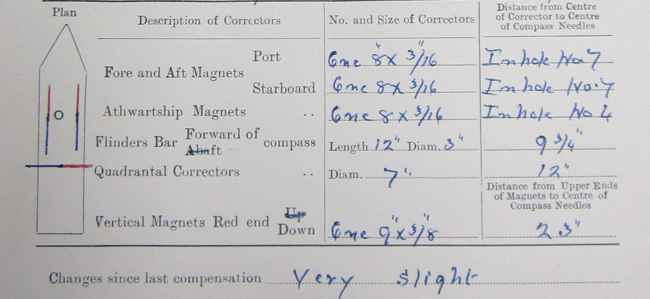 |
The Compass Adjuster was Captain A. Moore (NAA J2826, NQ1266) |
SOME JOHN BURKE LTD HISTORY
John Burke Ltd had become a limited liability company in 1915, formed around the core of the shipping business built up by John Burke and his son John Edward Burke. They offered the services of the company to the Queensland Government in 1920 when a dispute arose about the existing cargo service from Brisbane to the Gulf of Carpenteria. The contractors for this service - The Australasian United Steam Navigation Company (A.U.S.N. Co.) - had been running the service from Brisbane to Normanton since the 1890s, discharging and loading of cargo from the gold fields at Croydon. It was profitable only because of a mail subsidy from the government.
When the A.U.S.N. Company demanded a greater subsidy the government refused and the two parted their ways. In 1920 John Burke Ltd stepped in and offered to run a regular service from Brisbane to the Gulf ports via Townsville, Cairns and Cooktown provided the company received a government subsidy of £4000 and this was accepted. This subsidy increased to £6000 in 1947 and it was only when the basic wage and cost of living spiral hit in the 40s and 50s that the subsidy rose to £30,000 per annum by 1960. Wandana [see below] was the first ship to ply the route for John Burke. She continued her frequent visits in the post-war period until being replaced by the passenger vessel Elsanna (formerly a Dutch ship, renamed after Burke's daughters Elsie and Anna), until she too was replaced in 1957 by the appropriately named Waiben (the traditional name for Thursday Island).
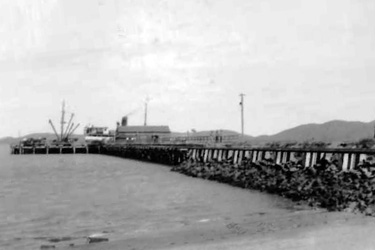 |
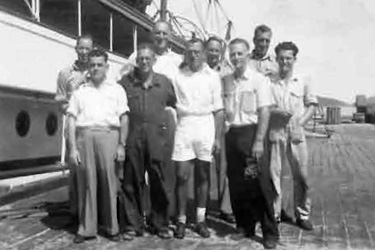 |
| One of John Burke's other ship - SS Wandana - at Thursday Island in the late 1940s. The Wandana replaced the old Kallatina for the Gulf trade (Normanton and Burketown) route in 1932. (H. Gates) | Crew of SS Wandana on the way to the Gulf. Photo courtesy of Harold Gates (behind man in dark overalls). |
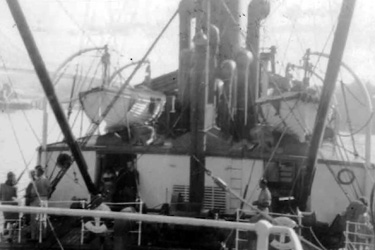 |
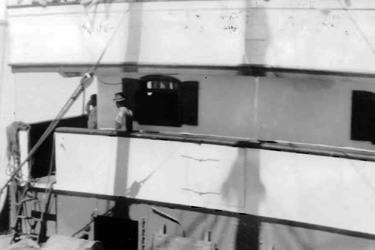 |
SS Wandana in 1948. (Harold Gates) |
SS Wandana. (Harold Gates) |
Discussions for the purchase of the Waiben from the Adelaide owners began in January 1957 and a price of £142,301 was agreed upon. This was contingent on Burke Ltd continuing to receive a subsidy and loan guarantees from the State Government (which were given). As mentioned, after the MV Waiben took over, the government was paying a £30,000 per annum subsidy to Burke Ltd for its coastal cargo services, of which the Waiben received about £11,200 pa. The story of the Waiben on the coastal route is described later on.
In late 1963 the government announced that they were not going to renew their contract with Burke Ltd but were going to throw it open to tender on the following terms: (a) general and freezer cargo service fortnightly to Thursday Island only; (b) no provision to service any other ports in the Gulf of Carpenteria; (c) carry non-government cargo as well. Tenders closed 8 January 1964.
There were two tenderers: Brisbane-based John Burke Ltd and Cairns-based Keith Holland Shipping Company Pty Ltd. Holland had started in 1959 at the same time the Waiben arrived to begin work on the Brisbane - Thursday Island route. Holland had the ships MV Maluka and MV Arafura Sea (99 tons). They ran these ships from Cairns to TI fortnightly, using non-union seagoing labour for crew and using this crew to load and discharge, presumably cutting out the use of watersiders (members of the Waterside Workers Federation). Very small tonnages were carried by Holland. Shortly afterwards, Holland acquired MV Katoora for the Cairns to TI route, and the Maluka for running cargo down the Gulf to Normanton and Burketown from TI or Weipa. They won very few customers away from Burke.
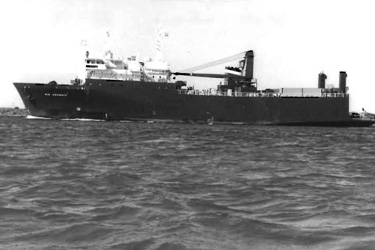 |
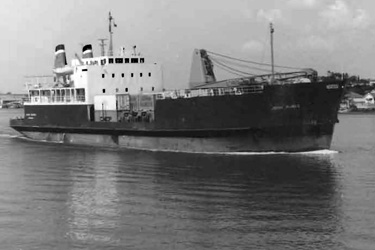 |
| 1980s - Burke ship MV Sid McGrath returns to Brisbane. (Brian Martin) | Early 1980s - MV John Burke returns to Brisbane. (Brian Martin) |
Burke Ltd put in several tenders, giving a choice of services. However, it is understood that Burkes were using Union personnel on seagoing staffs and registered Waterside Workers for loading and discharge their costs were going to be higher. As well, Burkes were committed to maintaining their ships to Lloyds 100A1 Class and also to Commonwealth and State Marine regulations whereas Holland was only State registered - which, it is claimed, added further costs to Burke's tender.
The Government awarded the contract to company Keith Holland Shipping which was to provide a service by rail to Cairns and then by ship from Cairns to TI. Burke Ltd first knew of the decision by way of a press statement by the State Treasurer on 21 May 1964, and was told their contract would expire on 15th November 1964. The Government believed that Holland Shipping would be able to offer a cheaper service in that they did not require a subsidy, and were also reducing their freight rate from Cairns to Thursday Island from £10.18.0 per ton to £7.5.0 per ton. Every business on TI, with the exception of one, signed a petition protesting against the Burke Ltd service being discontinued. The Normanton graziers and the various missions protested - but to no avail.
On paper it appeared that the Government was to save £30,000 pa in subsidies but there were other hidden costs that Holland incurred which did not show up in this estimate. It seems that Holland was being charged rail freight of £10 per ton from Brisbane to Cairns whereas anyone else would be paying £20 per ton. This subsidy of £10 per ton on Holland's rail freight of 6000 to 7000 tons per year would mean a cost to the Government of £70,000 per annum. This was far greater than the £30,000 subsidy being paid to Burke Ltd. Holland was going to use the 327 ton MV Katoora, which was 37 years old at the time.
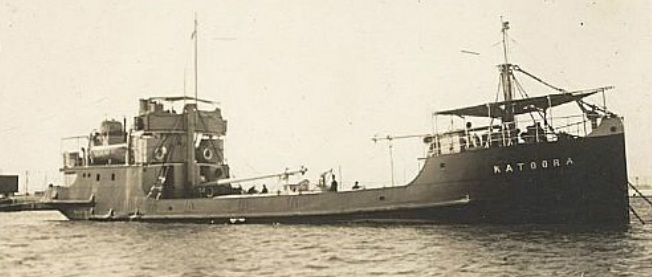 |
MV Katoora, 327 tons, 8 knots, was built by G. Brown & Co. of Greenock on the River Clyde in 1927 for the Colonial Sugar Refining Company. CSR had several "lighters" (small steamers) carrying sugar on the east coast and they were all operated by the Adelaide Steamship Company under contract. Katoora carried bag sugar from Innisfail to Cairns. During the war she was seconded to the war effort as "S-140" and carried US soldiers along the coast under United States Small Ships Command. On 8 November 1960 she was sold to Keith Holland Shipping company of Cairns and, with a new engine fitted, was used to ferry government goods from Cairns to Thursday Island in place of John Burke's MV Waiben. She also acted as a refrigerated prawn bulk handling vessel in the Gulf. Her usefulness as a sugar lighter came to an end when the mills of the Johnstone River district began shipping their sugar output direct from the bulk terminal at Mourilyan Harbour. In 1968 she was sold to Mornington Island Fisheries Pty Ltd Townsville who converted her into a trawler. She was listed as 'condemned' in Lloyds Register 1987 and decommissioned after sixty years of service. The Katoora was blown into the mangroves at Karumba in the Gulf during one of the many cyclones that frequent the region. Her wreck can be seen there today. |
It also seemed strange that the Waiben had 20 ton lift gear against the Katoora's 8 tons; the Waiben's cargo capacity was 1365 tons against the Katoora's 327 tons. It seemed like other factors had come in to play. The organisation behind Keith Holland Shipping was TNT - Thomas Nationwide Transport. The Governing Director of TNT was Mr K. W. Thomas who had sole control of the company. Keith Holland was the other director. He was also Honorary Secretary of the Queensland Country Party in Cairns. The Country-Liberal coalition had won a third term in office at the election in June 1963 and the conservatives would retain office until the end of their 11th term in 1989.
The decision to dispense with Burke Ltd meant that there was no longer a regular passenger service along the Queensland coast, and the Waiben was no longer needed. Normanton and Burketown were now left without a sea service, and Mornington Island Mission was isolated, and Edward and Mitchell River Missions would have to rely on bush tracks to bring goods in if the Mission launches from TI could not handle it. The loss of the subsidy was a severe blow to the company, however, new mining developments on Cape York helped them carry on as a cargo line. In 1965 the company wharf and office at South Brisbane was resumed by the Brisbane City Council forcing them to move their operations downstream - with more expense. The company introduced the all-cargo-carrying Alagna (named after Alice, Agnes and Anna Burke) in 1966, but the company was sold to the giant Dillingham Corporation in 1969. They supplemented the Alagna with the cargo ship John Burke in 1970. Jack Burke is reputed to have stated "No more family names'' and selected names like Waiben, Kuranda etc.).
 |
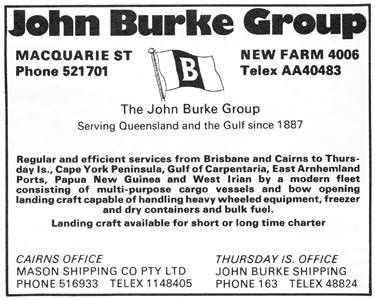 |
John Burke wharf 1960 (JOL) |
John Burke Group was a sponsor of the book "Timeless Isle" (John Foley, 1982) published by the Torres Strait Historical Society. |
Coastal shipping was now unprofitable and the company tried to expand into the New Guinea trade and the company's ships were re-registered in New Guinea to save money. The John Burke, the only vessel to be named after the Burkes was renamed Nuigini Kula. This new venture was not successful and the company was wound up in 1990 after 102 years of operation. At some stage there was seen to be a family feud in the Burke Family with Jack Burke joining the Freemason's and becoming interested in Masonic Affairs. This would seem to be be an odd development for an Irish Catholic citizen. Jack Burke was on the Board of Samuel Allen & Sons Ltd which was listed on the Stock Exchange and had the ownership of about 42 percent of the best North Queensland Hotels, and solid investments in the developing TV Industry. Samuel Allen & Co. stevedored Burke's ships in Cairns.
The Waiben was sold on Thursday 19th November 1964. She was bought by the Societe Mar Vate Vila in the New Hebrides (New Caledonia) and renamed Jacques Del Mar with a Port of Registry being Noumea. Four years later in 1968 later she was sold to Seaview Navigation Corporation, Panama and renamed Longlife; Port of Registry Panama. Early in 1972 she was renamed Royal Martin by the same Owners and Registry. In 1973 she was renamed Island Pearl (Panamanian) In 1973 but managed by Empire Navigation, Singapore. On December 23rd 1973 she struck a mine in the Mekong Estuary on a voyage from Phnom Penh to Singapore carrying a cargo of rubber and cartridge scrap.
Note: Another Waiben at Thursday Island was the Government Pilot Launch Waiben was a single screw wooden launch built for the Queensland Department of Harbours and Marine by Norman Wright in 1949, and was 14 m long, 3.7 m beam and 1.35 m draught. This pilot launch had a 40 hp Southern Cross diesel engine which gave her a top speed of 8.5 knots. It was transfered to Hay Point in 1977.
THE WAIBEN'S VOYAGES
The Waiben first trip began from the John Burke docks at South Brisbane - now where Southbank cultural precinct has been established. Master Mariner Denis Cleary was the most senior and experienced Master in Burke's company and in August 1957 he agreed to take command of the new ship. In late September he applied for a Packet Liquor Licence, with himself as licensee, to be able to serve alcohol aboard the ship and this was granted. Captain Cleary was appointed Master of the Waiben on 23rd October 1957 she left Brisbane on 26th October at 12.15pm. Waiben made 87 trips along the Queensland coast from her first journey in 1957 to her last one - terminating in Brisbane on 10 November 1964.
In the first half of 1959 Burke's financial statements show that the Waiben generated an income of: Freight £123,000, the Bar £676, Handling £2150, Passengers £11700 and Subsidies £5600, coming to a grand total of £143,500. Expenses, including wages of £21,769, resulted in a net profit of £18,736.
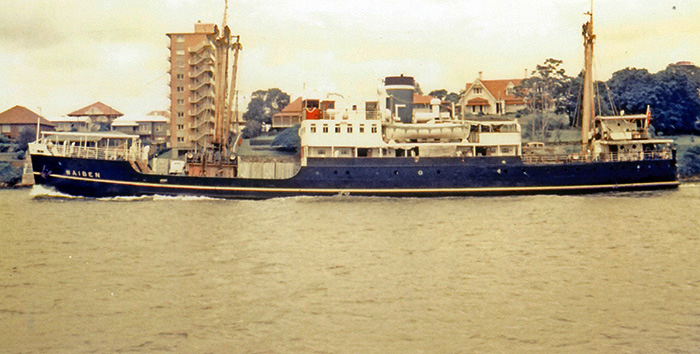 |
| The Waiben sailing out of Brisbane on 11 January 1964 on Voyage No. 75. She is pictured opposite Shafston House which at that stage was a RAAF Officers' Mess. Photo taken by Brian Martin and supplied by John Gates. |
Typically she would travel from Brisbane to Townsville, Cairns and Thursday Island. Here she would stay for about 4 days and then return to Brisbane via the same route and stopping at the same ports. Her total trip would take about 22 days and then she would have 7 days in Brisbane where the crew would have shore leave; and then be off again. My father, like most of the crew would spend that time at home in Brisbane. He would sometimes be called in to the ship but generally had a week's holiday.
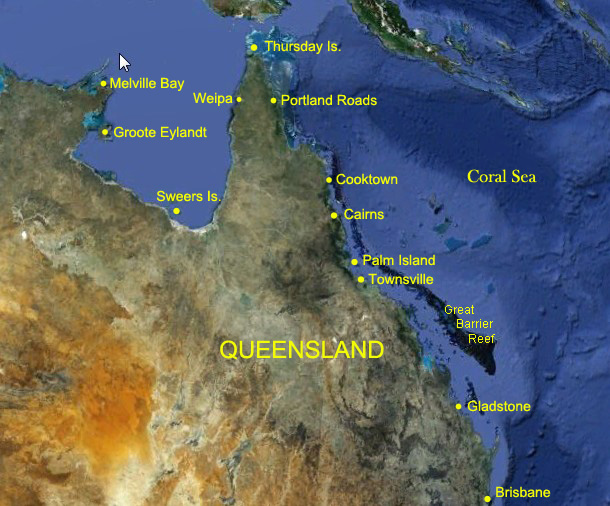 |
The ports and anchorages visited by MV Waiben in her eight years off the Queensland Coast. |
On ocassions, the Waiben would be called to make deliveries or pick up goods from other ports. The most common was the port of Weipa on the western coast of Cape York, Queensland. Here she would deliver equipment or collect bauxite for shipping to the refineries on the way back. In total she made 15 trips to Weipa with 7 of them in 1962 alone. Further comments about Weipa are made towards the end of this webpage.
The other destinations in the Gulf of Carpentaria for the Waiben were Melville Bay and Groote Eylandt. Melville Bay is the port for the township of Nhulunbuy which was created on the Gove Peninsula in the Northern Territory when a bauxite mine and deep water port were established nearby in the late 1960s. Waiben made one visit to Melville Bay on the 20 April 1958 to bring construction equipment, and then once in 1962 (30 March). In 1963, a Federal government decision excised part of the land for a bauxite mine to be operated by the North Australian Bauxite and Alumina Company (Nabalco). The Waiben made one in 1963 (25 September), and three in 1964 (30 Jan, 20 April and 14 June) which were to be her last. Melville Bay is a beautiful 5 km long curved beach, backed at the northern end by a 30 m high vegetated knoll. The town of Nhulunbuy was established in 1971 to service the mine.
 |
Some of the destinations of the Waiben in the Gulf of Carpentaria. Her main role her was to deliver equipment and supplies for the newly created mining sites of Weipa, Melville Bay, Angurugu and Umbakumba. The story of the disposession of aboriginal peoples from these areas is not a happy one. |
On Groote Eylandt there were two towns Waiben stopped at, and only the one time. The first, Angurugu, is located close to the mining town of Alyangula, which was established in 1965 by Groote Eylandt Mining Company Pty Ltd (GEMCO). Alyangula is now the main service centre for the people who live on Groote Eylandt. Waiben was at Angurugu on 28th September 1963 after visiting Melville Bay. The second town is Umbakumba which is located 70kms from the mining town of Alyangula. Waiben stopped here the next day (29th September). Today, permits are required to travel to Angurugu, Umbakumba and Nhulunbuy.
Waiben also stopped at Sweers Island Anchorage (in the southern Gulf of Carpentaria, just off the coast near Mornington Island) - just the once in April 1960. Petroleum exploration had occurred in the southern gulf since 1954 by private companies and the Bureau of Mineral Resources Canberra. This was despite continuous occupation by the Kaiadilt people. In 1960 the Dehli Australian Petroleum Company carried out geological surveys and stratigraphic drilling on Mornington Island and on the mainland. Perhaps equipment was being dropped off by the Waiben when she was at the safe anchorage at Sweers Island (see map below). Tourism did come to the island but that wasn't until Southers and Dickens built a shack in 1970; and that was later taken over by Broken Hill South, who investigated the Island as a potential shipping point for Lady Annie phosphate rock.
 |
| Sweers Island is located in Australia's southern Gulf of Carpentaria approximately 30 km off the coast, directly north of Burketown. The island is surrounded by acres of rock reef, with some coral. They say that much of the area has never seen a fishing line. |
Waiben would stop at various ports on her way to TI; not every trip but about three times per year (as the Government required). These included Portland Roads (one stop in each of the years 1959, 1960 and 1962), Cooktown (three stops in 1959 and 1962), Palm Island (21 August 1963) and Gladstone (1960).
Safety: every few days the crew would have to undergo various drills (preparing the lifeboats, testing hoses on hydrants, check bilge pumps, rocket party exercises and so on). The passengers would also have to muster next to the lifeboats to be given instruction in use of the boats. Crew accommodation was inspected weekly for cleanliness.
Illness: as would be expected, the passengers and crew would sometime get sick or injured. For example Greaser Peter Fagan was a passenger in a car involved in a car accident in Cairns on 23 March 1958 and was badly hurt. He didn't tell anyone but when he failed to leave his cabin for his watch when off Portland Roads they suspected something was wrong. He was dropped off at Thursday Island Hospital and had to attend as an out-patient every day for two weeks before being repatriated home (at his own expense). Steward Stanley Wight was also in a car accident at Cairns in May 1961 and ended up in Cairns Hospital and had to be paid off. Greaser Peter McCafferty - in July 1962 - fell backwards off a boatdeck railing and landed on the next deck striking John Gillon as he fell. Passenger Dr Perrett diagnosed two broken ribs and confined him to bed. He was sent to hospital on arrival in Brisbane. Also in July 1962 Cook Arthur Elephantis suffered a hernia and had to go to hospital. And poor old William Solomon (in November 1958) had a heart attack.
As well as crew being injured, sometimes it was the passengers: On one ocassion a Mrs Tutter fell down the companionway and the ship had to turn around and return to Brisbane. They were met by the Water Police and an ambulance. Other injuries included broken fingers, dermatitis and burns. In one particularly violent storm the Bosun was thrown from his bed and was seriously hurt.
Bad conduct: the crew would also sometimes relieve their boredom with drinking. However, on the 85 trips the Waiben made up and down the coast, drunkenness was only encountered a few times: names have been omitted but there was one incident in June 1958 where "James" was dismissed; "William" drunk in Cairns in February 1952 - dismissed; "Nicholas" drunk in Cairns in July 1958 and found asleep on the deck - fined £1. A pair of pantrymen were found drunk in the pantry in 1958. When sent to their quarters they used obscene language and refused to go. They were fined £1 each and instantly dismissed.
Strikes: John Burke had a good reputation amongst the union movement as a fair and responsible employer. It is no wonder then that only one strike occurred in the seven years the Waiben existed. On 27 April 1960 11 seamen refused to do their duty because (as they claimed) "the Seaman's Award was obnoxious to all thinking seafarers". They were charged with being AWL and fined two days' pay (about £7). The men were some of the ships' best: Alan Kidger, William McDonald, John Cooney, William Gould, Ernest Donovan, Frank Finch, Thomas Bryant, Partcik Fowler, Henry Ash and Geoffrey King. On arrival in Brisbane, the Captain reported to the Merchant Marine Office (who looked after the pay) that they men had displayed good behaviour since the incident and the fine was reduced to one day's pay with the agreement of the men.
CAPTAIN DENIS CLEARY Captain Denis Cleary was Master of the Waiben for most of its service in Queenland waters. He joined the ship in 1959 when it first arrived from South Australia and stayed as Master until his retirement in 1963. The Waiben was sold the following year. Denis Cleary was born on 21 June 1899 (Midsummer's Day he used to recall) in Enfield, London when it still had a village air about it. He was the son of Mr and Mrs J. D. Cleary - the fourth of seven (six sons and one daughter), and his father was in the Public Service. Denis enlisted for service in the Royal Navy Volunteer Reserve on 21 August 1917 and served until the end of hostilities. He was attached to shore establishments HMS Victory VI and HMS Pembroke while serving on various ships. In January 1918 he completed his signalman training and was appointed to the shore station HMS Vivid III as a signalman and was attached to ships on the North Atlantic convoy run until war's end. He was in Halifax, Canada at the time of the Armistice. Denis Cleary was demobilised on 10th February 1919. The sea-faring was on his maternal McGarry side - a brother was First Mate on the Cutty Sark at one stage, and died in Shanghai of yellow fever while on his own command. A nephew - Martin - became Senior Master for British Petroleum, and was invalided out after he had had a heart attack, aged 51, in Perth, Scotland. His family was in Dublin, and he spent much of his retirement lecturing in seamanship in Ireland. One of his sons went to sea for a while, too. There is quite a history of seamanship in the family. Denis continued to work as a merchant seaman and finally arrived in Melbourne, Australia as a crew member aboard the SS Ballarat on on 11 December 1929. He had visited Brisbane earlier and had decided it would be a nice place to live, so he settled there. Migrating with him was his younger brother, Charles, who married a member of the wider Burke clan and died of TB in the Blue Mountains in either late 1947 or early 1948. Charles was a Master for CSR ships between Sydney and Fiji. Denis obtained work as a Master with John Burke Ltd in 1929 and married Catherine "Kitty" Carroll on 23 October 1931 at Sacred Heart Catholic Church, Yeppoon. Over the next 30 years Captain Denis Cleary was Master of a succession of Burke's ships: Mygreta, Bidella (named after J. A Burke's daughter Bridgette (Biddy)), Alagna (named after Alice and Agnes Burke), Elsana (Elsie and Annie Burke), Wandana, and finally MV Waiben. During the time, war had intervened and Denis Cleary was to become Master of various requisitioned ships plying their trade for the Royal Australian Navy in New Guinea. Cleary's exceptional navigational skills came in handy when navigating the unchartered waters of some tricky rivers and reefs. He had learnt early to be able to "smell a reef" saying that the changes in marine life on a reef gave it a characteristic smell. Also in this time, Denis and his wife Kitty had four daughters and a son. They lived in the Brisbane suburb of Nundah. Upon retirement in 1963 he remained keen to stay involved with ships and shipping. He did "ship-keeping" at the South Brisbane docks where he would be the nightwatchman on moored ships. He could also pick up marine frequencies on his short-wave radio at home and with an aerial slung over the mango tree in his back yard at Nundah (Brisbane) he could listen-in to the ships' traffic. He also trained other seamen in the art of navigation. Captain Cleary died on 14 December 1977 of oesophageal cancer, and is buried in Nudgee Cemetery with his wife, who died in December 1989, aged 90. My thanks to Denis's daughters Berenice and Sheila, and daughter-in-law Deidre, for the information above. |
LAWRENCE 'LAWRIE' OLIVER AMIET
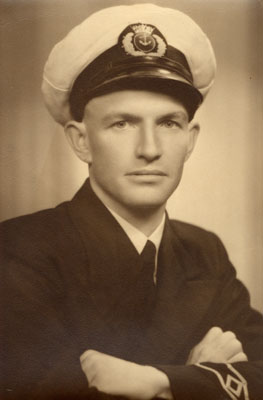 |
 |
Lawrence "Lawrie" Oliver Amiet served aboard the Waiben as the ship's radio officer. Lawrie served aboard the Waiben for the following periods: Apr - May 1961, Jul - Oct 1961, Jan - Jul 1962, Jan - Mar 1963.
Lawrence Oliver Amiet was born in Miles, Queensland, on the 2nd Aug 1915 and he died in Brisbane of cardiovascular disease on the 9th October 1982. He had a great interest in ornithology and took every opportunity whilst at sea to observe and record his sightings of birdlife. He published a number of articles (mainly on seabirds, naturally) in various ornithological journals and was a member of the Royal Australasian Orthinologists Union from 1959 onwards. His study of wader numbers was widely cited [see below]. He was found medically unfit to continue employment and the last ship he sailed on was the Gherringong in Aug 1979.
Amiet, L. (1957). A wader survey of some Queensland coastal localities. Emu. 57:236-254.
Woodall, P. & Watson, D. (1988). Wader numbers at Raby Bay, Moreton Bay: Changes over three decades. Sunbird: Journal of the Queensland Ornithological Society, v.18, no.4, Dec 1988, p.83-92.
Information supplied by nephew David Amiet.
THE WAIBEN AT THURSDAY ISLAND
FROM THE ROBERT WALDING PHOTO ALBUM
The colour photos below were taken by my father Robert Walding in 1961 and 1962 while he worked as Electrical Engineer on MV Waiben. They were all Kodachrome color slides taken with his Zeiss Ikon Contaflex 35mm SLR camera. Kodachrome film always did emphasise the blues but these slides have retained their colour beautifully over the past 50 years. This is not true of some of his other photos taken with Agfa slide film and Anscochrome which faded to a washed out magenta and had to be thrown out. The start of the captions are all his - written on the slide; but I am grateful to Vanessa Seekee for her additional words explaining the locations of each of the Thursday Island photos.
I contacted Vanessa because she and her husband Liberty own and run the Torres Strait Museum on TI and run Torres Strait Heritage Tours. They assist with research for new memorials, plaques, exhibitions, and act as advocates for veterans. That is why I contacted Vanessa for help with the captions. Their largest current project is the WW2 Torres Strait Conservation Project, which will see WW2 sites in the area conserved so that generations to come will enjoy and learn from them. They have written two books, 'Horn Island, In Their Steps, 1939-1945' and 'Discover Thursday and Horn Islands', co-written with Gordon Grimwade. Vanessa's Masters Thesis 'Horn Island and the 1939-1945 Star Medal' was submitted to Central Queensland University.
 |
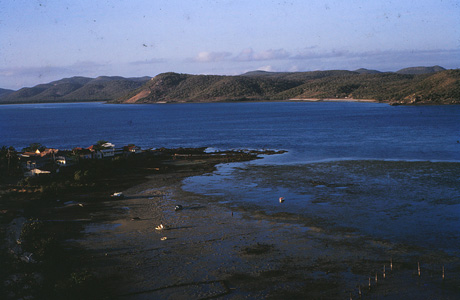 |
1-4. Deck of the Waiben - 1962. (Robert Walding) |
1-7. Thursday Island, 1962. In the foreground is the hospital on Thursday Island. This photo is taken from Green Hill and is looking at Prince of Wales Island. (Robert Walding) |
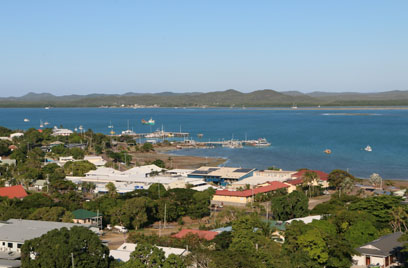 |
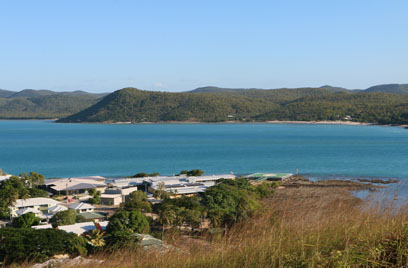 |
| From Green Hill (TI) looking over to Horn Island. Photo taken by John Huth, May 2015 |
The same scene as above but 53 years later. Taken by John Huth from Green Hill (TI) overlooking the hospital towards Prince of Wales Island. |
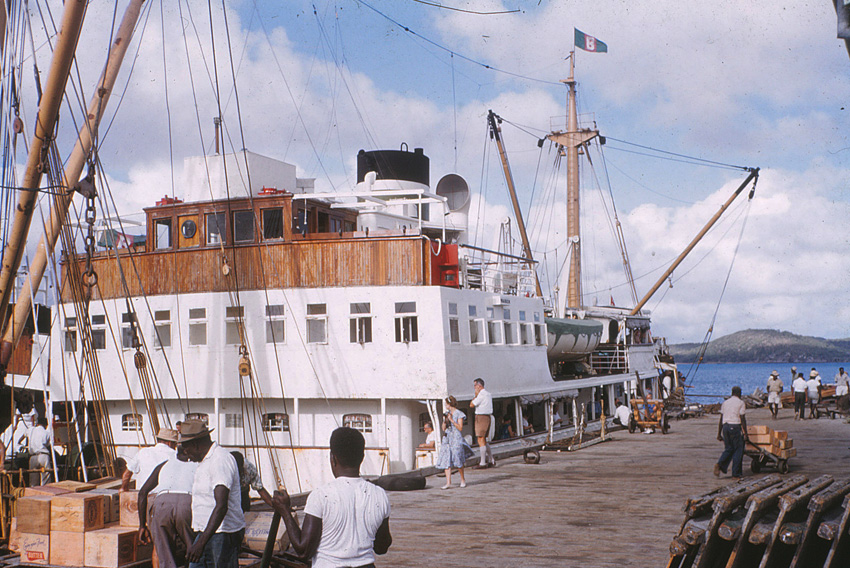 |
1-6. MV Waiben discharging cargo at Engineers Wharf, Thursday Island. (Robert Walding) |
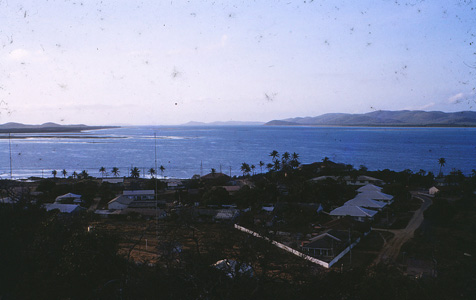 |
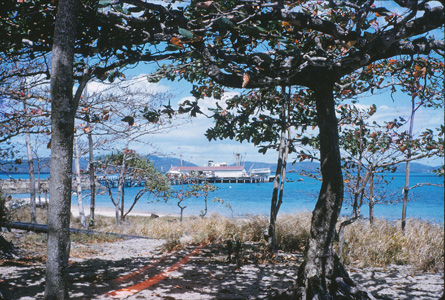 |
1-9. Thursday Island, 1962. This photo is taken from Green Hill and is looking down the passage to the mainland of Australia (in the middle, far away). The island on the right is Prince of Wales Island and on the left is Horn Island. (Robert Walding) |
2-17. The Waiben at the jetty - Thursday Island - 1962. (Robert Walding) |
CREW - 1961
A list of the entire crew of the Waiben 1957 to 1964 is at the end of this webpage.
| Denis Cleary | Master | Ernest J. Kear | A. B. | |
| Thomas W. Duncan | 1st Mate | Chris MacDonald | A. B. | |
| James Thomson | 2nd Mate | John Marion | 2nd Mate | |
| Hermond V. Helmkin | 3rd Mate | William A Prentice | Radio Officer | |
| Lawrence O. Amiet | Radio Officer | Darryl Penrose | A. B. | |
| Vincent Carnegie | Bosun | Genadry S. Osetroff | 1st Engineer | |
| Robert Chandler | A. B. | William J. L. Jackson | 2nd Engineer | |
| Harry Dawkins | A. B. | Neil S. Mackay | 3rd Engineer | |
| Owen Buckey | A. B. | Douglas R. Scales | 4th Engineer | |
| William H. Gould | A. B. | Robert Walding | Electrical Engineer | |
| William Cameron | A. B. | David G. Bell | Greaser | |
| Henry H. Ronde | A. B. | Peter Fagan | Greaser | |
| Ronald J. Birleson | A. B. | Mervyn Wilde | Greaser | |
| Raymond Brown | A. B. | Ray A. Norman | 3rd Engineer | |
| Douglas J. Moffat | Crew Attd | Keith J. Court | Greaser | |
| Karl Nilsson | A. B. | Maxwell Mehan | 3rd Engineer | |
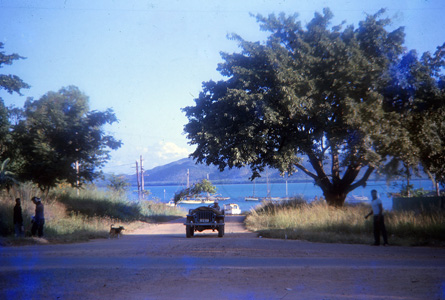 |
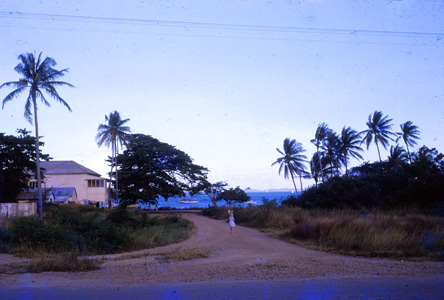 |
5-7. TI, 1962. Taken at the intersection of Douglas St (our main street) and Blackall St. Today the hardware is on the right and the outdoor cinema was on the left (it is now longer there). The photo is taken looking down Blackall St to the harbour, Prince of Wales Island is on the right. (Robert Walding) |
5-11. TI 1962. (Robert Walding) |
 |
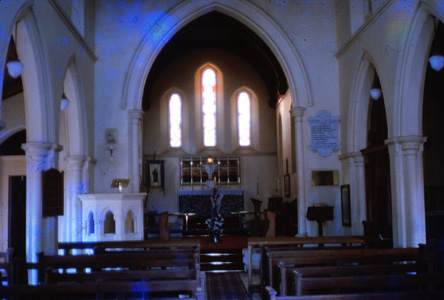 |
5-10. All Souls Quetta Memorial Cathedral, TI, 1961. The church was built in 1894 as the Anglican Quetta Memorial Church but took on its present name in 1900 when the diocese of Carpenteria was created. (Robert Walding) |
5-8. All Souls Quetta Memorial Cathedral, TI, 1961. The stained-glass windows were donated by the Torres Strait Pilot Service. (Robert Walding) |
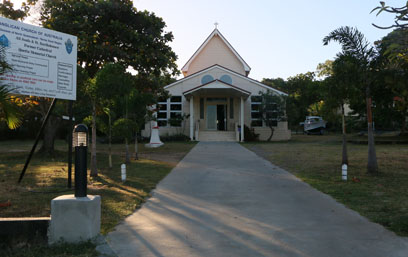 |
 |
| All Souls Church 53 years later. Photo by John Huth - May 2015 | Inside All Souls Church also 53 years later. (John Huth - May 2015) |
A TYPICAL TRIP TO THURSDAY ISLAND AND BACK
DEPART FROM |
DISTANCE |
Time (hr) |
Av SPEED |
ARRIVE AT |
||||
| Brisbane | 21Oct 1961 | 0910 hrs | 1400 km | 70 | 10.8 kts | Townsville | 24 Oct1961 | 0713 hrs |
| Townsville | 25 Oct 1961 | 0133 hrs | 350 km | 21.5 | 8.7 kts | Cairns | 25 Oct 1961 | 2302 hrs |
| Cairns | 28 Oct 1961 | 0005 hrs | 800 km | 57 | 7.6 kts | Thursday Is. | 30 Oct 1961 | 0918 hrs |
| Thursday Is. | 3 Nov 1961 | 1405 hrs | 800 km | 50 | 8.6 kts | Cairns | 5 Nov 1961 | 1549 hrs |
| Cairns | 7 Nov 1961 | 1628 hrs | 350 km | 14.5 | 13.0 kts | Townsville | 8 Nov 1961 | 0654 hrs |
| Townsville | 8 Nov 1961 | 1621 hrs | 1400 km | 61.5 | 12.3 kst | Brisbane | 11 Nov 1961 | 0718 hrs |
| Brisbane | 18 Nov 1961 | 1719 hrs | ||||||
| Total distance 5100 km, 274 hrs = Average speed of 10.0 knots | ||||||||
DISCHARGE CERTIFICATE
 |
| At the end of each contract period (usually six trips or so) the men would be discharged and given a certificate - as shown above. |
Reminiscences about Thursday Island - from Neville Macklan, Townsville, QueenslandI lived on Thursday Island with my parents from 1961 to 1963 (I was aged 11 when we arrived). My father was the Superintendent of the Q.A.T.B. during this time. He had an 8mm movie camera which he took various shots of and he took a couple of shots of the Waiben coming into the main wharf and once when my grandmother was a passenger on the Waiben which I think she boarded in Townsville and returned on it again on its next round trip. The 8mm film was converted onto a VHS tape many years ago and since reproduced onto a DVD. I remember when the Waiben arrived the local Malay fishermen became wharfies. In those days the ships' cooks threw all the "slops" over the side whilst in port. One day I threw my 100 lb-breaking-strain line into the water the same time the slops were thrown over and ended up catching a 47 lb black trevally. Well, I did not actually land it, one of the Malay fishermen came to my rescue.
During my 3-years spent on T.I. I have so many memories. Actually, last July (2014) I went back to T.I. for a trip for the first time in 51 years and stayed for a week and met up with some people from those days and some of the islanders who remember my father and mother. The ambulance centre was near on the corner of John/Douglas and Milman Streets. The ambulance centre is still in the same spot and has not actually changed much in 51 years. I showed the staff at the centre a lot of footage of the ambulance and some old photos of it also. I'm sure a lot of old timers would recall a lot of memories by reading and looking at some of the old pictures. Some of the pictures on the website were taken near where the ambulance centre was and still is. I wonder if my father Kenneth Macklan had actually met with some of the people who worked on the Waiben!!. After 51 years not much has really changed on T.I. A lot of the old buildings are still there.
One big difference is the length of the main wharf which is only approximately one-third of what I remember. Us kids used to paddle our corrugated iron canoes under and around the main wharf, and yes, right at the very end where the boats moored. We did not know or recognise how dangerous it was then. The Malay fishermen said the sharks would not be interested in us as there was enough fish around to keep them from being hungry!!!!! |
 |
 |
| On the beach near the Ambulance Station - looking west with lugger on Bowden's slipway - 1962. (Neville Macklan) |
The same beach as to the left - July 2014. Note the similar shape of the hilltops on Prince of Wales Island in the background. (Neville Macklan) |
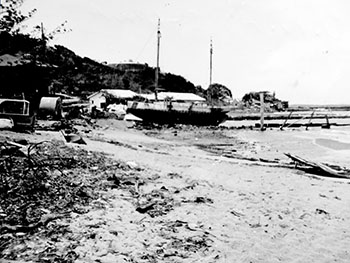 |
 |
| The beach near the ambulance station - looking east with a lugger on the IIB (Island Industries Board) slipway - 1962. (Neville Macklan) | The same beach as at left - July 2014. The background is still similar; also note the timber pole near the beach. (Neville Macklan) |
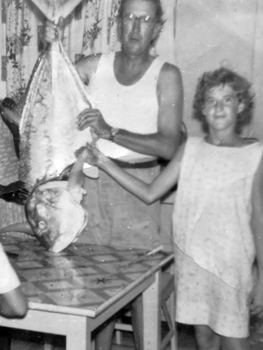 |
 |
| Black trevally caught by Neville Macklan off the main wharf when the Waiben was in port - 1962. Neville said "If I recall properly it was 47 lb but looking at it now I wonder if over 52 years it may have grown in weight." Pictured are his father Ken and sister Esmay. | Neville Macklan (aged 11, left) and brother Wayne in the backyard of the ambulance. The beach in the background is that shown in the photos above. (Neville Macklan) |
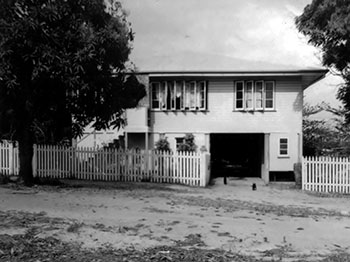 |
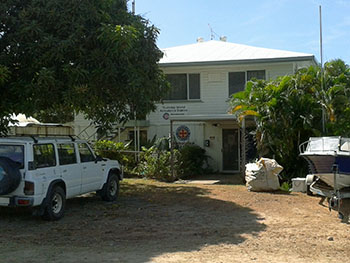 |
| Queensland Ambulance Transport Brigade, TI 1962. (Neville Macklan) | QATB - now known as the Thursday Island Ambulance Station - July 2014. (Neville Macklan) |
 |
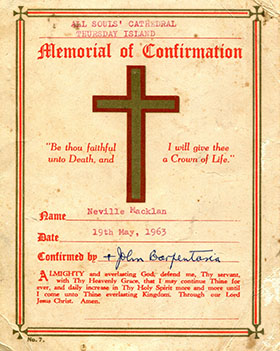 |
| QATB Superintendant Ken Macklan and wife Jean in bowls attire outside the Ambulance Station in Milman Street - 1962. The ambulance is a snub-nosed Bedford. (Neville Macklan) | Quetta All Souls' Confirmation Certificate - 1963. (Neville Macklan) |
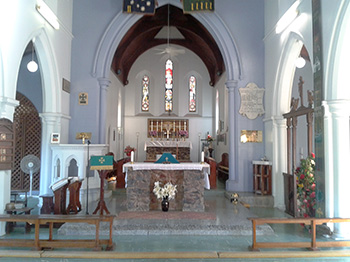 |
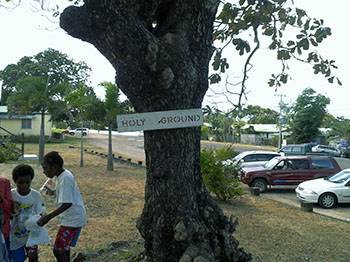 |
| Inside the Anglican Church, formerly the All Souls Quetta Memorial Church - July 2014. (Neville Macklan) | Sign ut the front of the Anglican Church, formerly the All Souls Quetta Church - July 2014. (Neville Macklan) |
CHRISTMAS DAY 1961
When the Waiben departed Brisbane on 15th December 1961 the crew knew they'd be away from home for Christmas. The Captain - Denis Cleary - arranged to have a special Christmas lunch prepared for the crew and passengers and had menus printed. They departed Cairns at 11.43 pm on the 23rd December and by lunchtime on Christmas Day they were at the tip of Cape York, passing York Island - just a few hours from Thursday Island. The menu below shows interesting selection, including an entree of Consommé Royale - a soup served with pieces of firm, savoury custard (made from egg yolk and milk, and flavoured with salt and pepper) floating in it; barramundi fillets a la salamander (overhead grill); roasts of beef, pig and turkey; Pennsylvania ham; Christmas Pudding with brandy and so on.
 |
 |
Christmas Menu 1961 |
A great Christmas lunch was had by all - overlooking York Island. Click on the image to see an enlarged view. |
The kitchen and wait crew must get a special mention for their efforts. Chief Cook was Arthur Elefantis; 2nd Cooks: Ron Mitchell and Fred Robinson; Assistant Cooks: Michael Brown, Ken Hayes; Chief Steward Stan Wright; 1st Grade Stewards Noel S. Smallhorn, Everard Elliott, Leonard W. Stanford, Desmond McDade, Robert A. Nelson; 2nd Grade Steward: Peter Robinson; Pantrymen: Edward G. Furber & Howell O. Bodsworth.
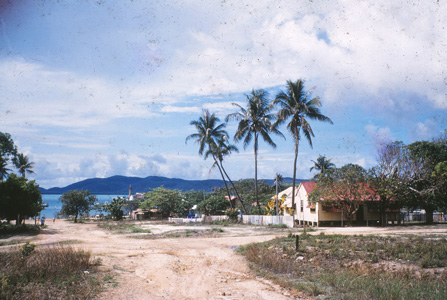 |
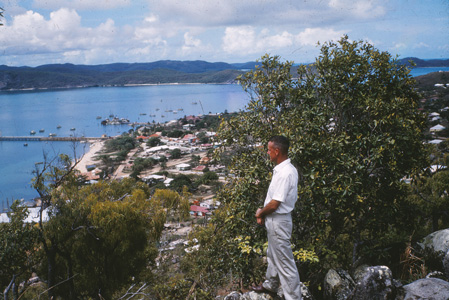 |
4-2. Thursday Island, Xmas 1961. This area is called Quarantine and is looking across Aplin Passage to Hammond Island. The road is Waiben Esplanade.
(Robert Walding) |
4-5. Waiben Electrical Engineer Robert Walding standing on Milman Hill overlooking the township of Thursday Island. You can see the Waiben moored at Engineer's Wharf (the smaller wharf) to the left. Prince of Wales Island is in the background. Taken in December 1961. (Robert Walding) |
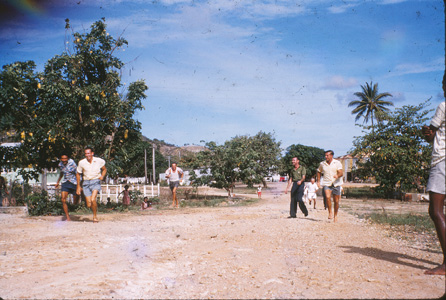 |
 |
4-9. Waiben crew have a foot race at TI, Christmas Day 1961 soon after they arrive. Taken about 4pm on Douglas St, Thursday Island where the Torres News office is today, with Milman Hill in the background. (Robert Walding) |
4-15. Vince Carnegie on TI, late afternoon Xmas Day 1961 in Douglas Street. Milman Hill is in the background. (Robert Walding) |
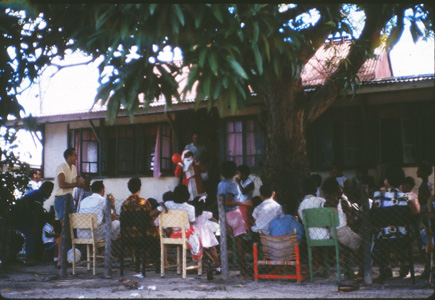 |
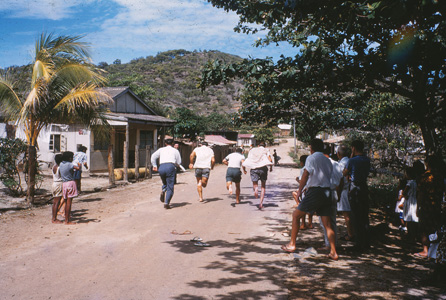 |
4-16. TI Christmas Service 1961. (Robert Walding) |
4-17. Waiben crew have a foot race in Douglas St, Thursday Island on Boxing Day; a rematch from the previous day. Milman Hill in the background. Photo taken where the Torres News Office is today. (Robert Walding) |
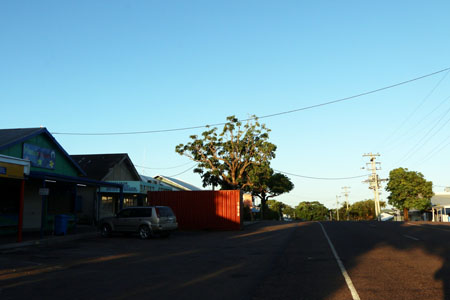 |
| Douglas Street, Thursday Island, 10th May 1915 at 5.54pm. Same scene as in the footrace above, just over 53 years later. (John Huth) |
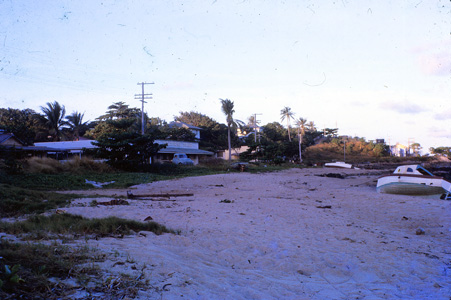 |
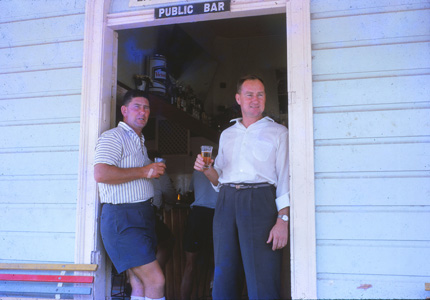 |
5-13. TI, 1962. This shot is taken from the beach with the Esplanade on the left. This beach looks down the passage to the mainland. The Federal Hotel is on the left (just out of shot). (Robert Walding) |
3-3. Cooktown - Monday afternoon 25 June 1962 - Waiben crew: left Ron Costin (3rd Engineer), right Neil S. McKay (3rd Engineer). (Robert Walding, Electricial Engineer) |
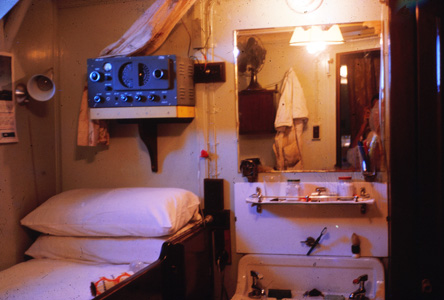 |
 |
5-1. Robert Walding's cabin aboard the Waiben 1961. That's a Kenwood Trio 9R-4J shortwave radio on the shelf that my father converted to run off the ship's 12 VDC supply. He paid about £20 for it. (Robert Walding) |
5-3. TI. (Robert Walding) |
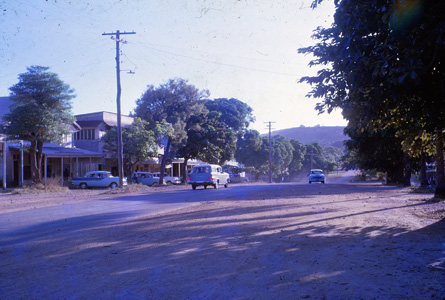 |
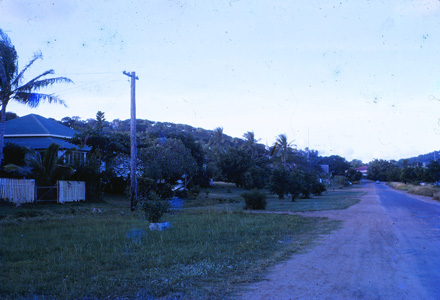 |
5-6. TI. (Robert Walding) |
5-12. TI. (Robert Walding) |
A comment from Stan Wright:
I lived in the suburb of Waiben on Thursday Island for 10 years 1990-2001. The local spelling of the name is Waibene and I think this name was given to the whole of TI to indicate it did not have any local water on it. (Still doesn't - a pipeline from Horn Island supplies water to TI and Hammond Island next door). The locals pronounce the name as Wyben. As for the ship - about the time of my first arriving on TI in 1987 John Burke Shipping Co was the water transport company. From that time on other companies came and went with Seaswift remaining the dominant company. A chap on TI, Bill Shibasaki was the Manager of John Burke Shipping [JBS]. He grew up on TI and was interned during the war as a lad. Bill secured a good job with Island Indrustries Board [IIB]. After Bill resigned from JBS, an ex London Policeman - Fred Thompson - took over. JB's office had an excellent young woman named Cindy Drummond who I believed clocked-up almost 20 years of service. |
Comments from Len Graham. Len worked for Burns Philp Shipping Department at TI. The office was open Monday to Friday and Saturday Mornings, whereas all other divisions of Burns Philip worked just weekdays. Len said that Burns Philp made sea travel bookings for Indian canecutters who wished to visit their homeland. John Burke's office also handled Ansett Airline's passenger bookings and airfreight.
Genady "Gerry" Osetroff was the Chief Engineer aboard the Waiben from 1957 to 1962 and was well known to all locals dependent on shipping. He arrived one Saturday morning and placed a grocery order for miners who he was in partnership with in the Portland Road/Iron Range Area. He paid in about $100 and requested the foodstuffs be shipped on the next outward vessel calling at Portland Road. Money was paid in at various times and the miners posted in grocery orders. Cartons of syrup and sliced beetroot were often purchased to trade with the local Aboriginals for fish and crabs. Peninsular Aboriginies considered these items as "Number 1 Tucker". After some years Osetroff disappeared and if my memory is correct he joined one of the American Pioneer Line vessels The Pioneer Isle or the Pioneer Gem which were often in the Port of Cairns loading frozen cartons of Hamburg Meat, walnut logs and so on. Sometimes Osetroff would come into BPs [Burns Philip] and invite me for beer at the Criteron Hotel next door. Arthur Ahmat was a dark skinned Malay/Chinese chap who grew up on Thursday Island and was Secretary/Treasurer of the TI Branch of the Waterside Workers Federation. Arthur would fly to Sydney each year and attend to WWF All-Ports Meeting. Arthur was the first "Colour TI Citizen" to be invited to join the TI Bowling Club. Arthur became a good bowler and often played with Ian Smith who was one of John Burke's Engineers [4th Engineer aboard the Waiben 1957-1960]. Arthur was invited to play at the Indooroopilly Bowls Club in Brisbane and sent 25 kilos of Coral Trout and Red Emperor as a welcoming gift. He cooked these fish 'native style' with banana leaves etc which was a big night at the Bowls Club. They were surprised that Arthur could play so well on a turf green as all he had played on previously was a rubber green at TI. Ian Smith when in Cairns would visit the Masonic Lodge I was a member of and I would drive him back to the ship. |
THE WAIBEN AT PORTLAND ROADS
 |
Sign on the wall of the Tourist Office. (John Huth May 2015 |
 |
Portland Roads in the early 1970s - photographed by Max Moulds. Max is an entomologist of some renown. He has travelled over all of Australia over the last 50 years collecting all types of insects. |
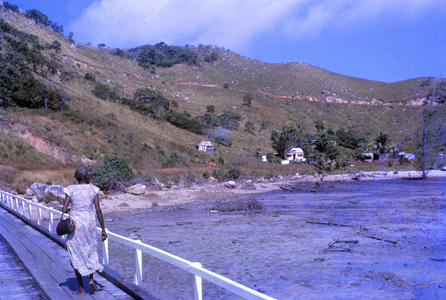 |
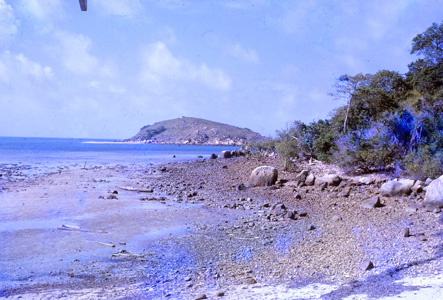 |
5-3. Portland Roads 1961. This is a small community that began as a port when gold was found at the nearby Iron Range in 1935. It also saw a lot of activity in WW2 with an airfield being built here. (Robert Walding) |
5-4. Portland Roads 1961. After WW2, with gold mining long gone, the area became a popular fishing and recreation stop. The Waiben came here to drop off supplies. (Robert Walding) |
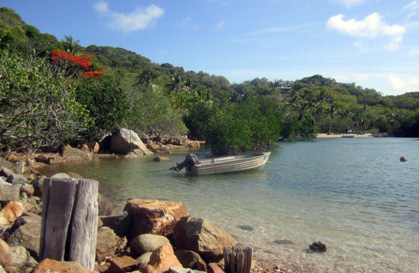 |
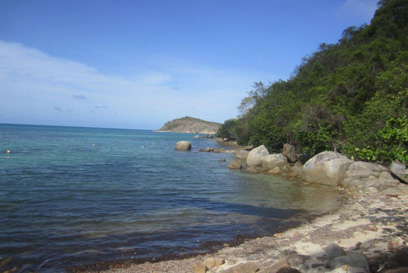 |
Portland Roads today, 54 years later. What a difference. See photo above. (John Huth, May 2015) |
Portland Roads today. Compare with photo above. (John Huth, May 2015) |
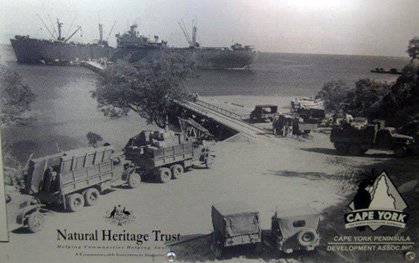 |
 |
Wartime at Portland Roads. Photo of information panel in tourist office at Portland Roads. The jetty as seen in this photo must have lasted until at least 1962. (John Huth, 2015) |
Map showing location of Portland Roads. Photo of information panel in tourist office. (John Huth, May 2015) |
A comment from Len Graham (Len was Wharf Manager at Cairns for Keith Holland Shipping followed by 22 years with Mason's Shipping. Len's brother Peter was a senior Captain for Mason's Shipping Company and was a deck officer on John Burke's Alagna.)
| It was well known that after the Waiben discharged its cargo at Portland Road the vessel would proceed to a nearby reef and the passengers and crew would commence fishing hoping to secure Coral Trout, Red Emperor etc. One of the ships greasers Cec Casey would stay on deck and watch the lines. Whilst the passengers were having lunch Len would secure lids from 20 litre drums to their lines. After the meal the passengers would check their fishing lines and state they had caught a large fish and pull their line in. Much fun and laughter was generated by Len's activity. As Thursday Island is a port that is classified as 'daylight only' and for a ship to spend 2-3 hours fishing was an accepted practice rather than the ship "anchor off" T.I. for 2-3 hours on Monday morning. Cecil Casey's home port was Cairns and he lived at the Australian Hotel for many years. |
PORTLAND ROADS PHOTOS FROM THE ALBUM OF MR. BOWSER
Mr Bowser donated his vast collection of shipping photos to the Cooktown Shire Council Library who passed them on to the Cooktown Historical Society. I am indebted to Marge Scully of the Society for providing me with these photos and many more that appear below. Mr Bowser was a seaman aboard M.V. Cora that made runs around the Gulf from Thursday Island to Burketown, Normanton, Mornington Island, Borroloola, Vanderlin Island, Roper River, Groote Eylandt and occasionally to Cairns and Townsville. After retirement, Mr Bowser moved to St George, Queensland.
 |
Waiben at Portland Roads wharf with trucks from BHP, Iron Range. May 1959. (C & A Bowser) |
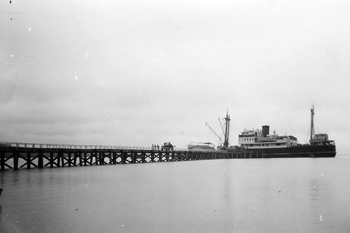 |
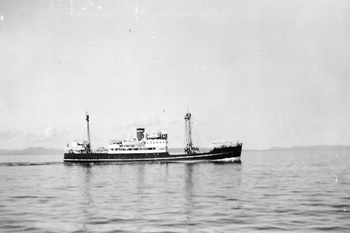 |
| Waiben berthed at Portland Roads - May 1959. (C & A Bowser) | Waiben near Portland Roads - May 1959. Taken from aboard MV Muluka on way to Torres Strait. The Muluka was one of two of Keith Holland's vessels servicing the Gulf trade in competition with the Waiben. The political intrigue about the Waiben and Maluka was mentioned earlier in the description of why John Burke's company folded (and the Waiben sold). (C & A Bowser) |
 |
Waiben berthed at Portland Roads - May 1959. (C & A Bowser) |
THE WAIBEN AT CAIRNS
(awaiting photos)
THE WAIBEN AT COOKTOWN
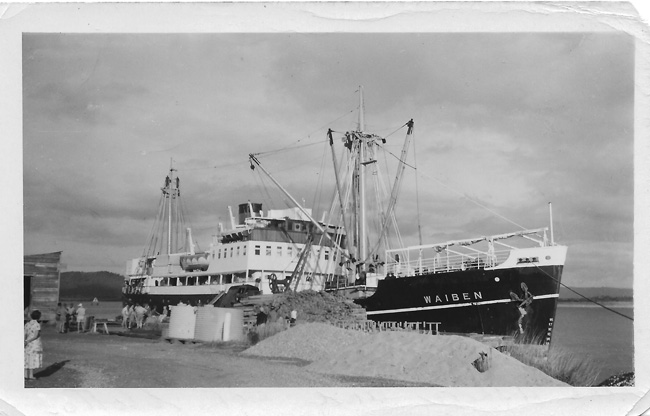 |
| Caption on the back reads "May 1959. Cooktown Wharf. Arrived on a Sunday night and the Captain, passengers and crew all went ashore and got blotto." [Marge Scully] |
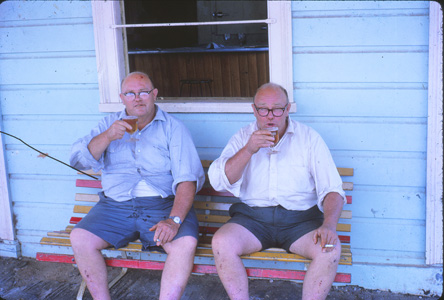 |
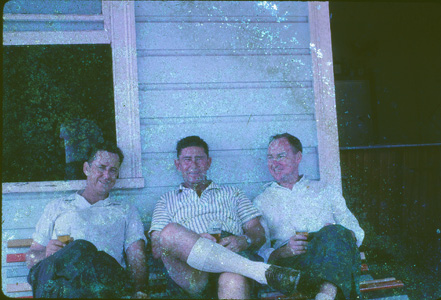 |
3-4. Waiben passengers - at the Cooktown Hotel, 25th June 1962. (Robert Walding) |
3-5. The Waiben arrived at Cooktown, at 4pm on the 25 June 1962 and the crew and passengers headed off to the Cooktown Hotel. L to R: Ron Costin (3rd Engineer), passenger, Neil McKay (3rd Engineer). (photo Robert Walding) |
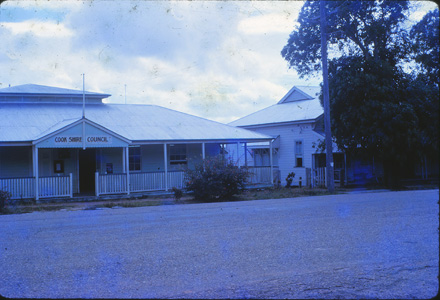 |
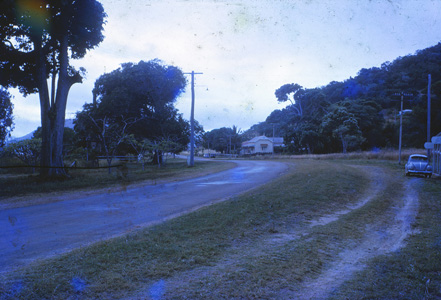 |
3-7. Cooktown Shire offices - Tuesday 26 June 1962. (Robert Walding) |
3-8. Cooktown - 26 June 1962. (Robert Walding) |
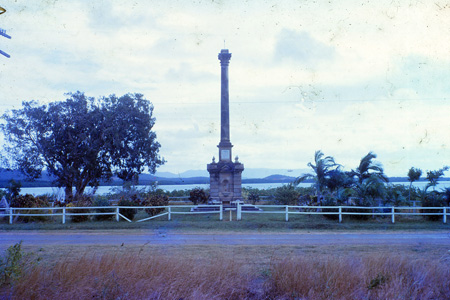 |
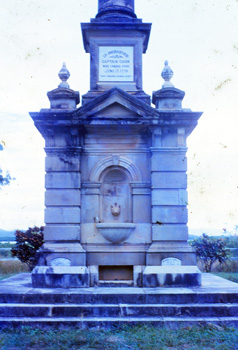 |
3-9. Cooktown - Captain Cook Memorial 26 June 1962. (Robert Walding) |
3-10. Cooktown - Captain Cook Memorial - 26 June 1962. (Robert Walding)
|
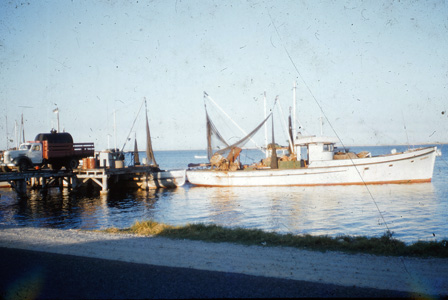 |
| The old Cooktown wharf taken from the east side looking to sea. Geoff Whaling identified the location in this photo. He said "I visited the wharf in the 1960's with my uncle Stewart Habermann a skipper of Hayles' launches and I have visited the wharf many times in the late 1970's to mid 1990's when near Cooktown whilst surveying." (Robert Walding) |
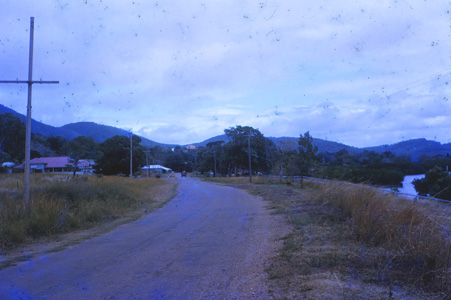 |
 |
3-12. Cooktown - 26 June 1962. (Robert Walding) |
3-16. Waiben - Robert Walding's cabin in 1962. He was the Electrical Engineer. The James Campbell & Sons calendar is open at July 1962 after the Waiben left Brisbane on 7th July. His wife Heather (my mother) worked in the despatch for Campbells in Creek Street, Brisbane. (Robert Walding) |
THE WAIBEN AT BRAMPTON ISLAND
 |
View from Brampton Island hill with Waiben in the distance - May 1959. (C & A Bowser) |
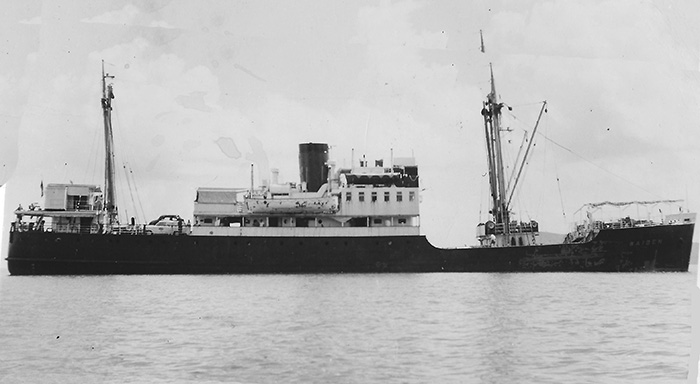 |
Waiben off Brampton Island - May 1959. (C & A Bowser) |
THE WAIBEN AT HAYMAN ISLAND
 |
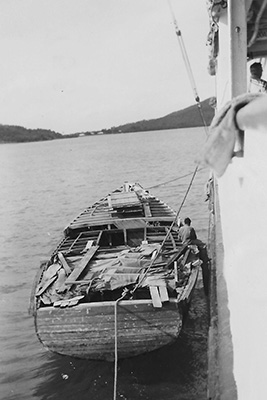 |
| Waiben at Hayman Island July 1959. (C & A Bowser) | Partially complete hull along the Waiben waiting for an engine a Hayman Island. (C & A Bowser) |
THE WAIBEN AT PALM ISLAND
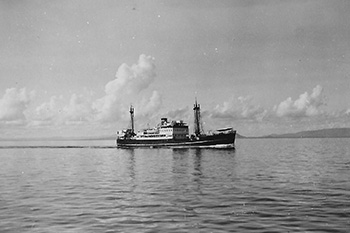 |
 |
Waiben heading north fully loaded. (C & A Bowser) |
Waiben at Palm Island - 1959. (C & A Bowser) |
THE WAIBEN AT WEIPA
Weipa is now the largest town on the Gulf of Carpentaria coast of the Cape York Peninsula in Queensland, Australia - but back in 1962 it was hardly more than a disused aboriginal mission. Commercial quantities of bauxite were discovered on these Aboriginal lands at Weipa in western Cape York in 1955 which spurred a chain of dispossessions; thousands and thousands of kilometres of Aboriginal land was stolen and ravaged in the service of profit. The "Comalco Act of 1957" revoked the "Aboriginal Reserve" status, giving Comalco 5760 square km of Aboriginal reserve land on the west coast of the Peninsula and 5135 square km on the east coast of Aboriginal-owned (though not reserve) land for bauxite mining. Mining commenced in 1960.
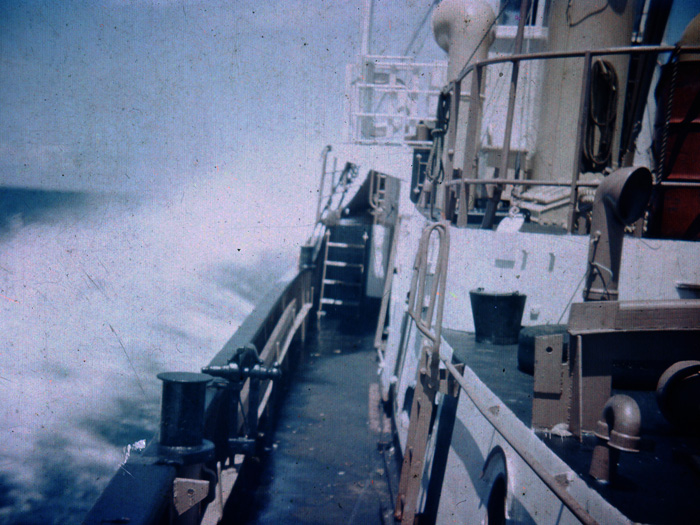 |
Waiben experiencing big seas in the Gulf - 1962. (Robert Walding) |
In its voyages around the Queensland Coast from 1958 to 1964, the Waiben visited Weipa a total of 15 times. Her first visit was 23 April 1960, followed by visits on 20 October and 24 Nov the same year. She made no stops in 1961 but had a very busy year in 1962: 21 June, 17 July, 14 August, 15 September, 11 October, 9 November and 7 December 1962. In 1963 she stopped four times: 1 April, 29 June, 28 July and 17 December. Her very last visit before the Waiben was sold was 17 May 1964 - and that was it for evermore. When the Waiben travelled to Weipa, the journey from TI took about 17 hours to cover the 270 km. For example, she departed TI on 13 Aug 1962 at 1534 hrs and reached Weipa 17 hrs later on 14 Aug at 0846 hrs. This was an average speed of 8.6 knots. Her return journey saw her leave Weipa on 17 August 1962 at 1534 hrs and arrive at TI on 17 August at 0655 hrs. This was an average speed of 9.4 knots for 15.5 hrs.
 |
Photo 5-16. A Caterpillar scraper bowl assembly being offloaded on to a dumb barge from the Waiben to another barge (the Comel, pictured on the shore) at Weipa in the Gulf of Carpenteria, Queensland on Thursday 21 June 1962. (Robert Walding) |
Some notes on the above photo: The Waiben had just arrived that morning at 9.30 am. This Caterpillar was used in the early development of the bauxite mine. Its role was to strip topsoil and stockpile it for regeneration. The scraper would also be used for road building (haul and development roads). In the background you can see some very simple and effective development at Evans Landing. The stockpile is raw bauxite. Also shown is an early conveyor system that has been constructed and is used to load barges. The barges were towed out into the protected estuary to load larger coastal bulk carriers. In this period (early '60s), the river mouth was not dredged and only shallow access was available alongside at Evans Landing. The bauxite was loaded by clam grab from the barges to the vessel's holds. The Waiben was loaded with the mined bauxite. Nowadays, all bulk carriers are direct loaded with conveyors and offloaded by elevating bucket conveyors at Lorim Point 2 km to the right (east). The ramp behind the conveyor incline in the background shows that a dozer pushed the bauxite up to a hopper bin which fed the conveyor. The stockpiles are now operated with dozers, by bottom feeding hoppers and underground conveyors. The mess and dongas [single men's quarters] were about 1 km to the right of the blue truck. The first test loading of bauxite from the conveyor belt loader to the left was into the hold of the Westminister Dredge WD 53 on contract to Comalco to widen and deepen the port entrance at Gonbung Point. The Waiben stayed for 3 days and left on Saturday 23 June 1962 at 1.30 pm. Comalco's Marine Forman at the time was Lenard Hatchman.
My thanks to Leonard Hatchman for information about the location of this photo and the equipment aboard. He said "in 1969 I serviced and repaired that Cat scraper as a first year apprentice diesel mechanic". And "My father Lenard James Hatchman was employed by Mason Shipping Company as First Mate, then progressing to Captain operating the port tug, Tully Falls, and a number of coastal vessels mainly to Papua New Guinea, Timor and also to Weipa. One of those craft was the Wewak which was an American LCT barge during WWII. On one of these trips to Weipa he actually had on board - and loaded to the gunnels - the first building supplies which when assembled were the corrugated tin, hardwood frames, push-out window dongas for the Comalco contractors. The actual spot where the Wewak nosed onshore is where that barge - the Comel - is situated in the photograph [above]". You may also see some vehicles in the background. Len said "One of those Landrovers parked near that Blitz truck was my father's company vehicle". "The major bauxite loading facility at Weipa today is at Lorim Point, a further 5 km east up river of Evans Landing".
I'd also like to thank Peter Crane, Rio Tinto engineer who worked at the Weipa mine in the mid-90s, for some of the detail about the photo above and the information that follows: In 1961 the initial mining had been started and export of bauxite to overseas customers (mainly Japanese) was still a year or so off. Weipa didn't really get firmly established in bulk export until about 1966. The photo is an excellent portrait of the ongoing development. The stockpile was growing, the early export equipment was in place and operating and development was pushing on. The supply barge on shore was the prime mover for most vehicles (like the old blue International Ute and the two Series 2 Land Rovers and the Chev Blitz truck) and other goods and perishables supplied from the coastal freighters. The living accommodation at Evans Landing is a kilometre or so to the right in the photo. It was pretty rudimentary corrugated steel shacks built on concrete stumps. Some of the remnants of the early 60s camps were still there in the mid-90s when I was there. The area is now mostly the 'contractors' area and still with rudimentary donga accommodation. The town is about 7 km to the north of this photo approximately in a line projected vertically up from the head of the conveyor in the photo. At this stage (as shown in the photo), the town was not established. The Weipa development was under Comalco control and the Aboriginal mission of Napranum (Weipa South) is the early settlement there, about 10 km south (to the right) along the river shore.
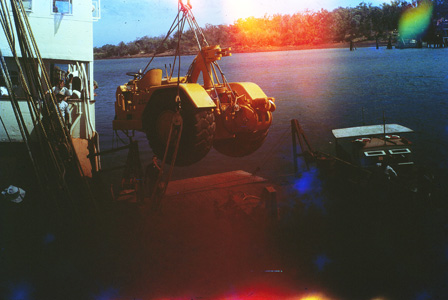 |
5-17. The annoying problem of lens-flare! This photo was taken moments after the one above. The first equipment for Weipa's large-scale handling of ore was delivered May 1962 by the John Burke ship Waiben. The load of 450 tons was lifted with the ship's gear on to barges, which took it ashore. Further shipments of this equipment, including waterfront gear and conveyors for delivering the ore from the stockpiles into the ship's hold. [Source: Queensland Government Mining Journal, June 1962]. (Robert Walding)
|
Bauxite is generally found in a shallow horizon in the Cape. Mining is conducted by clearing and grubbing the vegetation, then stripping and reserving the 1-1.5m of topsoil. The bauxite horizon is between 1 and 4m, on average depth. 'Mining' is pretty simple, more like landscape gardening. Dozing creates a vertical work face and then front end loaders simply work the face in a horizontal stripping process. The work face advances in to the bauxite deposit. The front end loaders fill trucks (often modified tippers with articulated bottom dump bodies). Excavators may be used in early stages of creating a deep enough working face for the front end loader to operate in. As the Cape is fortunate enough to be lateritic, the effort required to loosen the pisoliths is minimal, hence the front end loader is an easy and efficient process. So, your Dad [Robert Walding] was a pioneer in this field - he helped build an ongoing resource which is still being expanded today.
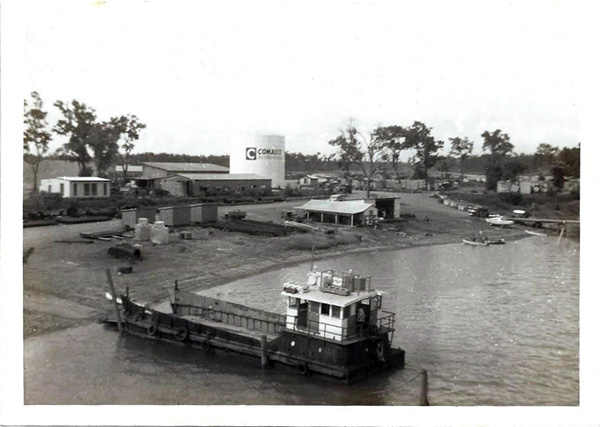 |
Evans Landing circa 1964-1965 taken from the walkway on the bauxite shiploader. At the top left we can see the workshops, diesel fuel tank, and in the foreground the barge Comel, the marine workshops, and slipway near the shoreline. Further to the right of photo we can see part of Westminster's Jetty; directly behind is the camp mess, dining room buildings, and there is also an open air movie theatre. Amongst the trees the main single men's quarters ''dongas" are plainly visible. This area has been expanded throughout the years as Weipa progressed. (Leonard Hatchman, 1964) |
HAPPY TIMES ABOARD THE WAIBEN
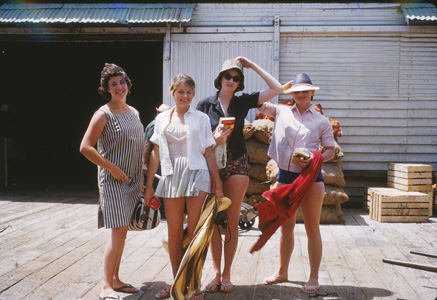 |
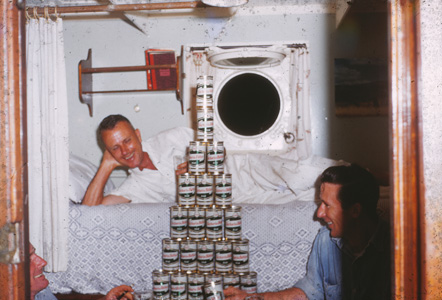 |
6-4. Waiben passengers - Townsville to TI, 1962. The ship had accommodation for 12 passengers and separate cabins for men and women. (Robert Walding) |
6-7. Electrical Engineer Robert Walding in bunk in Bosun's Cabin - Waiben. Photo taken by Bosun Vince Carnegie. (Robert Walding) |
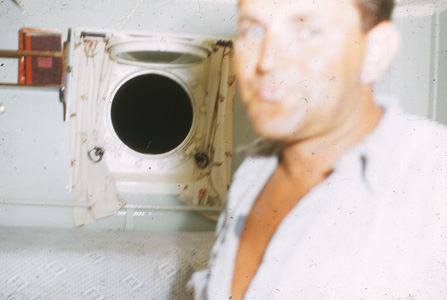 |
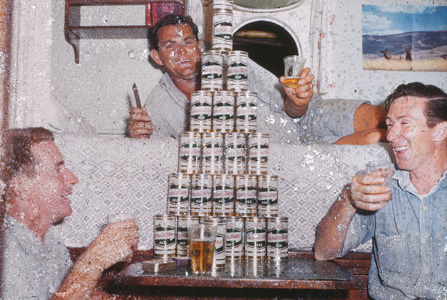 |
6-8. An out-of-focus shot of Bosun Vince Carnegie - MV Waiben. (Robert Walding) |
6-9. Bosun Vince Carnegie (on bunk) and two seamen. (Robert Walding) |
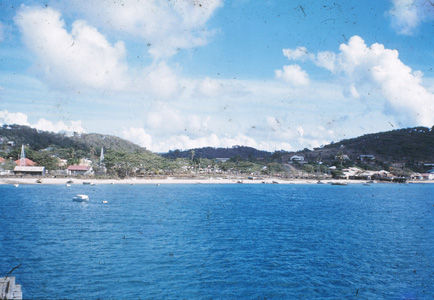 |
 |
6-10. View from Waiben. Location unknown. Any ideas? (Robert Walding) |
6-16. Waiben unloading at TI. (Robert Walding) |
THE LAST DAYS OF THE WAIBEN - 1964
The Waiben's last year plying her trade up the Queensland coast and into the Gulf was in 1964. That year she made 11 trips (numbered 75-85) between 11th January and 7th November 1964, and that was it.
 |
| The last voyage of the Waiben, pictured in front of the Storey Bridge in the Brisbane River, departing on her final trip to North Queensland - 16 October 1964. Captain Douglas Benedict McCormack was the Master. (Brian Martin) |
At the start of 1964, John Burke didn't realise this was to be her final year in Queensland. Some interesting documents have turned up to support this. Historian Hilda Maclean from the School of Social Science at the University of Queensland, was invited out to view the station diaries of the Lawn Hill cattle station (1923- 1965). This lease for this station was taken over to develop Century's open-cut mine at Lawn Hill, 250km north-west of Mount Isa in the Lower Gulf of Carpentaria. The station diaries are a valuable historical resource and it was important to see them before the mine closed in September 2015 and the archived transferred. Pinned to the inside cover of the 1964 diary was a memo from John Burke dated 31 October 1963 outlining the Waiben's proposed sailing schedule for 1964. Hilda sent these on to me as she knew I'd be interested. If you go to the end of this page you can see them in full.
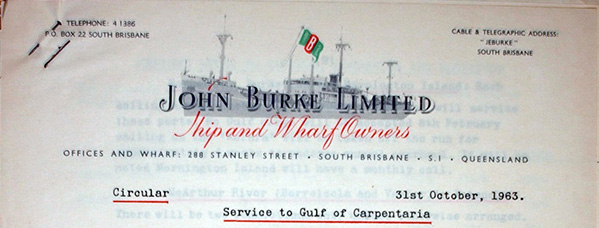 |
The letterhead for the 1963 letter. Scroll to end of webpage to see the rest. |
As mentioned earlier, the Waiben was bought by the Societe Mar Vate Vila in the New Hebrides (New Caledonia) and renamed Jacques Den Mar with Portr of Registry Noumea. In 1968 she was sold to the Seaview Navigation Corporation, Panama and renamed Longlife; Port of Registry Panama.
 |
Jacques den Mar ex Waiben |
In 1972 she was renamed Royal Martin by the same owners and registry. In 1973 she was sold to Panamanian Owners but managed by Empire Navigation, Singapore, and renamed "Island Pearl". 1973 she capsized and sank in Mekong Estuary on passage from Phnom Penh to Singapore, and became a total loss. Her remains lie there today.
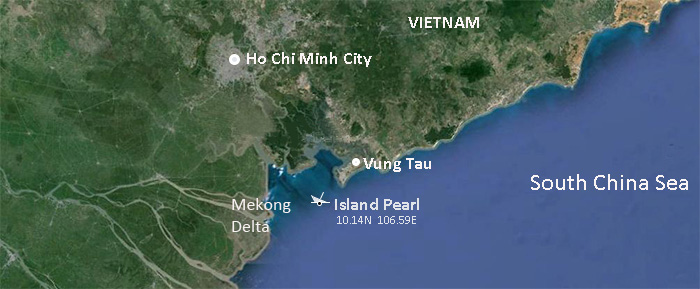 |
Map showing the final resting place of the MV Island Pearl, ex Waiben, ex Morialta. |
REMINISCENCES OF CAPTAIN ALEX R BURNS
During 1970 – 1971 Captain Alex Burns sailed briefly on the ship as a junior officer when it was operating out of Singapore. Here are some of his memories of those days.
I first saw the Royal Martin when I accompanied my father (Captain A R Burns) and a Mr Vinh Co to a reception on board when she was berthed at Jorong, Singapore in January 1970, at that time the ship was owned by Mr Vinh Co and my father was a director in the company. Mr Nguyen Phuoc Vinh Co was a Vietnamese gentleman who was a member of the disposed Vietnamese Royal Family. In 1968 he met a Colonel James Bogart of the US Army in Vietnam, they formed an informal partnership in which Mr Vinh Co would buy two ships and James Bogart would operate them from Singapore. The two ships were the Galle, price about S$730,000 which was renamed Marilisa, after the names of Bogart's two daughters and the other vessel purchased was the Jaques Den Mar, price about S$416,000 and renamed Long Life, because Mr Vinh Co considered it an auspicious name. Bogart went to Singapore and being an army man and not knowing the first thing about shipping, teamed up with a Keith Taylor who ran a Company called British Asian Shipping Pte Ltd and the ships were placed under their managements. Within a few months, Mr Vinh Co arrived in Singapore and tried to take control of his ships, but Bogart had all the paperwork showing him and Keith Taylor as owners and they refused to relinquish control. Mr Vinh Co had to arrest his own ships to gain control, which was a costly and lengthy process. After a few months he managed to get back the Long Life. By 1969 Mr Vinh Co had teamed up with my father and they established a Singapore company Winker Lloyd Pte Ltd (Winker being and Anglicisation of Vinh Co) to Manage the ships. Mr Vin Co decided perhaps the name Long Life was not so auspicious and at the suggestion of my father renamed her Royal Martin. The royal being for his family connections. This was in 1969. The ship traded locally around Singapore, Malaysia, South Vietnam, Cambodia and went as far as Hong Kong. From memory I can advise: 1969 Master - Captain George Reid 1970 Master - Captain Andres Andersen 1970 Master - Captain Latif 1971 Master - Captain Pierre Dani I sailed on the ship for two brief periods of a few months, first before I went for my Second Mate's Certificate. I had served my cadetship with Benline, a UK liner company and had gone on leave to get my 'ticket' in Singapore, but the examiner said I was too young and must wait for 5 months until I was 20. Consequently, I was sent on board the Royal Martin as uncertificated 3/O. Captain Anderson, the Norwegian master, thought my competence was above that of the 2/O so he switched us round and I became her 2/O at the age of 19. For some reason the old 2/O did not like the demotion and quit just before sailing and the purser had to act as 3/O Crewlist as I remember: Master Andres Andersen The Malay crew believe the ship to be haunted. There was a brass plaque in the Dining Saloon forward bulkhead which loosely said: At the Reviewing of the Fleet at Scapa Flow on 11 June 1942, his Majesty King George VI gave the order, 'Splice the main brace', from the bridge of this ship. This was the first time in history that such an honour has been conferred on a merchant ship. I wish I had taken a photo of the plaque. We did foil an attempt one even by a bunch of Frenchmen who were scheming to steel the plaque. From you photographs [above], your father's cabin remained as it was. The officers had moved down from the bridge deck to the forward passenger cabins and the vacated officers' cabins were requisitioned by the Captain to give himself a suite. The Chief Officer had two passenger cabins giving him a day room and a bed room. The rest of the accommodation remained pretty much as she was, in her day she had been a fine ship in her day, but was beginning to look a little tired. She had mahogany veneer bulkheads in the saloon and a double sweeping staircase do to the passenger an officer quarters below. When I got my Second Mate's ticket I returned to the ship as C/O. Under the Panama Flag you could do anything you liked in those days. I remained for a month before leaving to join Jardine Mathison as 3/0. On the 2nd voyage the Master was a teetotalling Frenchmen, Pierre Dani, he said he didn't need to brink as his wife Mdm Dany Dani who sailed with him, at a bottle of brandy a day drank enough for the ship's complement. The E/E had changed to a Frenchman, born and raised in Saigon and he couldn't speak one word of English. First voyage the ratings were all Singapore Malays and by the second voyage they had changed to Cambodians. So, we had a situation with six Cambodians who could not speak English and one Brit who could not speak Cambodian; after a few weeks all the Cambodians English language skills were progressing quite nicely. At some time in 1972 the Royal Martin was placed on bareboat charter to Bishop Intercostal Lines Pte Ltd, this was run by an American, Felix Bishop. Mr Vinh Co even gave him S$100,000 to get him started. Bishop ran the ship for a year, sometimes paid the crew and charterhire, but no other bills were paid and the ship was repossessed by Winker Lloyd who were left to sort out the mess. Resultantly Bishop disappeared and as you may know all bills associated with a ship become the responsibility of the Owners, irrespectively whether nor not incurred by them. The result of this, after fighting off creditors and lengthy court cases in 1973 the ship was auctioned at a Sherriff sale and required by Empire Navigation Pte Ltd, Singapore, and renamed Island Pearl. Empire Navigation was established by the directors of Boon Siew Motors who hold the Honda dealership in Singapore. I met them, there was a Mr Saw, a Mr Lui and one other, if I think hard enough I will remember his name. I think a Mr Boon. Empire Navigation liked to do things on the cheap and employed the cheapest crew they could find. In January 1973 they sailed from Phnom Penh to Vung Tau with a cargo of vehicles and rubber. Anticipating bad weather, the C/O believed it prudent to put the cars in the lower hold and the rubber on deck. Once they got over the river bar and into the Mekong Delta Bay, the ship capsized in shallow water. Alex R Burns [pers. comm. 26 October 2017] |
Note; it is sometimes claimed (by dive tour operators) that the ship finished her days after being mined or bombed by the Viet Cong off Phnom Penh. Alex Burns refutes this: "I would imagine that the dive operators only wished to embellish her sinking to make it more appealing to divers. The area where she sank was well outside the capabilities of the VC, there is no way they could have targeted the ship where she was during inclement weather. I did a couple of Phnom Penh runs on her and once we were outside the river or in Phnom Penh it was considered safe. On the river passage we travelled in convoy with the protection of small patrol boats, as we were the victims of rockets, machine gun fire and light arms. Fortunately during my time on board we only received one hit through the boatdeck window from a rifle shot, fired by the ARVN (Army Republic of Vietnam). Although some of the other ships in the convoy were hit by rocket fire."
WAIBEN CREW
There are 15 Log Books for the Waiben and are as follows. The No. 1 Log Book is for the final voyage of the Morialta but I have included it here. Log Book 6 is missing from the National Archives (Cannon Hill, Brisbane). Each Log Book contains the crew details, safety drills, the departure and arrival at all of the ports (and the tide soundings). Many of the entries with the same surname may not be different men. I think the recording and spelling of names in the ship's log may have been a bit error prone. Are Richard and Ronald Barnett one and the same for instance?
| Log Book | Depart Brisbane | Arrive Brisbane | Days |
| 1 | 03-Aug-57 | 12-Nov-57 | 101 |
| 2 | 23-Oct-57 | 10-Apr-58 | 169 |
| 3 | 11-Apr-58 | 24-Sep-58 | 166 |
| 4 | 23-Sep-58 | 18-Mar-59 | 176 |
| 5 | 19-Mar-59 | 02-Sep-59 | 167 |
| 6 | 03-Sep-59 | 14-Feb-60 | 164 |
| 7 | 25-Feb-60 | 13-Aug-60 | 170 |
| 8 | 31-Aug-60 | 04-Jan-61 | 126 |
| 9 | 04-Apr-61 | 14-Oct-61 | 193 |
| 10 | 15-Oct-61 | 09-Jan-62 | 86 |
| 11 | 18-Jan-62 | 30-Jun-62 | 163 |
| 12 | 01-Jul-62 | 14-Jan-63 | 197 |
| 13 | 24-Jan-63 | 10-Jul-63 | 167 |
| 14 | 11-Jul-63 | 08-Jan-64 | 181 |
| 15 | 09-Jan-64 | 24-Jun-64 | 167 |
| 16 | 25-Jun-64 | 10-Nov-64 | 138 |
COMPLETE CREW LIST 1957 - 1964
| No. | Surname | First Name | Position | Logbook |
| 1 | Adams | Robert | AB Seaman | 11 |
| 2 | Affley | Declan J | AB Seaman | 13,14 |
| 3 | Ahboo | Manap | Crew Attendant | 12 to 16 |
| 4 | Allen | Douglas James | Asst Cook | 4 |
| 5 | Allen | John | Greaser | 12 |
| 6 | Amiet | Lawrence Oliver | Radio Officer | 4-6,9,10,13 |
| 7 | Anderson | Norman | 1st Grade Steward | 2 |
| 8 | Anderson | Hillary | 1st Grade Steward/P'Man | 2,3 |
| 9 | Anderson | Maurice | Crew Attendant | 14,15 |
| 10 | Andresen | Bjarve | AB Seaman | 2,13 |
| 11 | Ash | Henry M | Greaser | 7 |
| 12 | Ashton | Harry J | 1st Grade Steward | 2,3,5-8 |
| 13 | Ashton | Charles | AB Seaman/Bosun | 12,13 |
| 14 | Ball | Richard T | AB Seaman/Crew Attendant | 4 to 8 |
| 15 | Banks | John | 1st Mate | 2,3 |
| 16 | Barden | Kenneth B | Asst Cook | 14,15 |
| 17 | Barker | Colin A | 3rd Engineer | 12,14,15 |
| 18 | Barnett | Ronald | AB Seaman | 4 |
| 19 | Barnett | Richard | AB Seaman | 5 |
| 20 | Barram | Alfred | Greaser | 13,14 |
| 21 | Beach | Graham J | Electrical Engineer | 12,13 |
| 22 | Beaver | Maxwell | 1st Grade Steward | 4 |
| 23 | Bell | James | Asst Cook | 7,8 |
| 24 | Bell | David G | Greaser | 9 to 16 |
| 25 | Bell | George W | Greaser | 13 |
| 26 | Bevis | Neil E | Ordinary Seaman | 4,5,14 |
| 27 | Bird | William | AB Seaman/Bosun | 11,12 |
| 28 | Birleson | James | AB Seaman | 3 |
| 29 | Birleson | James R | AB Seaman | 7 |
| 30 | Birleson | Ronald James | AB Seaman | 10 to 14 |
| 31 | Birleson | Leonard | AB Seaman | 14 |
| 32 | Birleson | Joseph | Greaser | 16 |
| 33 | Blay | Thomas | Pantryman/Chief Steward | 7,8,12-16 |
| 34 | Bodsworth | Howard D | 1st Grade Steward | 7,8 |
| 35 | Boorman | Frederick | Asst Cook | 2,3 |
| 36 | Boyes | Colin O | AB Seaman | 7,8 |
| 37 | Brady | Bernard | 1st Grade Steward | 2 |
| 38 | Breen | Robert 'Bobby' | AB Seaman | 12 |
| 39 | Brown | Raymond W | OS/AB Seaman | 9,10,11 |
| 40 | Brown | Alan H | 2nd Mate | 13 |
| 41 | Browness | Jack | Greaser | 13 |
| 42 | Brownrigg | Gore | Greaser | 2 |
| 43 | Bryant | Thomas A | Ordinary Seaman | 7,8 |
| 44 | Buckley | Owen | AB Seaman | 9,10 |
| 45 | Burgess | David | 3rd Mate | 2,3,4,5 |
| 46 | Burns | Basil | 4th Engineer | 2 |
| 47 | Calvert | Harold M | AB Seaman | 15,16 |
| 48 | Cameron | William | AB Seaman/Bosun | 2,9,10,13,14,16 |
| 49 | Cameron | Duncan | AB Seaman | 16 |
| 50 | Campbell | Donald A | Radio Officer | 13,14,15 |
| 51 | Cant | Edward R | 1st Grade Steward | 14 |
| 52 | Cargill | David | AB Seaman | 14,15 |
| 53 | Carmody | Leslie | Greaser | 9 |
| 54 | Carroll | John | Crew Attendant | 12 |
| 55 | Casey | Richard | Greaser | 14 |
| 56 | Casey | Cecil W | Greaser | 15 |
| 57 | Chambers | Thorpe | 1st Mate/Master | 3-6,11-15 |
| 58 | Chandler | Robert | AB Seaman | 9,10,14 |
| 59 | Clayton | Robert J | 1st Grade Steward | 11,12 |
| 60 | Cleary | Denis | Master | 2 to 14 |
| 61 | Clubley | John W | Greaser | 15 |
| 62 | Collinson | James | AB Seaman | 11 |
| 63 | Collyer | Gilbert | 1st Grade Steward | 2 |
| 64 | Colpaert | Richard | 1st Grade Steward | 2 |
| 65 | Cook | Gordon | 1st Grade Steward | 14 |
| 66 | Cook | Archibald F | 2nd Cook | 14 |
| 67 | Cooney | John | AB Seaman/Crew Attendant | 7,15 |
| 68 | Costin | Ronald E | 4th Engineer | 2-5,11-16 |
| 69 | Court | Keith J | Greaser | 10,11 |
| 70 | Crowley | Allen | AB Seaman | 12 to 14 |
| 71 | Cucinotto | Salvatore | AB Seaman | 12 to 15 |
| 72 | Cunningham | Patrick | 2nd Cook | 3,4,5 |
| 73 | Curley | Lane | 1st Grade Steward | 2 |
| 74 | Curtis | John | 1st Mate | 11 to 16 |
| 75 | Dallaway | Leonard J | 2nd Cook/Chief Cook | 11-14,16 |
| 76 | Daly | Wrixon | 2nd Cook | 2 |
| 77 | Davidson | Ian G | 2nd/3rd Engineer | 8,9 |
| 78 | Davies | Cyril | 1st Grade Steward | 3,5 |
| 79 | Dawkins | Harry | Greaser | 2,10,12 |
| 80 | Dawkins | Henry | AB Seaman | 9 |
| 81 | Dawson | James | Electrical Engineer | 7,8,9 |
| 82 | Della | Michael | Deck Boy | 15,16 |
| 83 | DeLundi | Ronald | 2nd Grade Steward | 16 |
| 84 | DeVigny | Cyrus W | 1st Grade Steward | 15 |
| 85 | Donnelly | Reginald T | Greaser | 12,13,14 |
| 86 | Donnelly | Colin M | Electrical Engineer | 15 |
| 87 | Donovan | Ernest | Crew Attendant | 7 |
| 88 | Dowser | Noel S | 4th Engineer | 5 |
| 89 | Duignan | Noel L | Ordinary Seaman | 12,13 |
| 90 | Duncan | Thomas W | 1st Mate | 10 |
| 91 | Durman | John | Crew Attendant | 12 |
| 92 | Dwyer | Patrick J | Greaser | 2,4,5 |
| 93 | Dwyer | Noel S | 4th Engineer | 4 |
| 94 | Dye | James | 1st Grade Steward | 4 |
| 95 | Elefantis | Arthur | 2nd Cook/Chief Cook | 7,8,11-14 |
| 96 | Elliott | Edward | 1st Grade Steward | 12 |
| 97 | Fagan | Peter | Greaser | 2,9,10,12 |
| 98 | Fagg | Alfred B | AB Seaman | 7, 14-16 |
| 99 | Feather | Leslie E | 1st Grade Steward | 13 to 16 |
| 100 | Fenlon | Timothy | Greaser | 2,3 |
| 101 | Finch | Frederick B | AB Seaman | 3-8,16 |
| 102 | Fitzgerald | John E | AB Seaman | 3,4,5 |
| 103 | Foran | Brian J | 1st Grade Steward | 12,13 |
| 104 | Fowler | Patrick | Greaser | 7,8 |
| 105 | Freidman | Neil R | AB Seaman | 4,5,12 |
| 106 | Frew | Albert | AB Seaman | 2 |
| 107 | Fuller | Roy L | Greaser | 14,15,16 |
| 108 | Furber | Edward G | Pantryman/Chief Steward | 7,8,11-15 |
| 109 | Gardiner | John A | Asst Cook | 15 |
| 110 | Garrett | Terence D | AB Seaman | 16 |
| 111 | Gatlick | Nicholas | 1st Grade Steward | 2 |
| 112 | Geary | James | AB Seaman | 2 |
| 113 | Giles | Joseph | Asst Cook | 7 |
| 114 | Gilles | Lindsay | 2nd Mate | 8,9 |
| 115 | Gillespie | William | 1st Grade Steward | 8,12 |
| 116 | Gillon | John | 2nd Mate | 11,12 |
| 117 | Glover | Selwyn H | Radio Officer | 2 to 9 |
| 118 | Gould | William H | AB Seaman/2nd Mate | 7 to14 |
| 119 | Guy | Edward M | AB Seaman | 3-5,14 |
| 120 | Hamilton | John H | AB Seaman | 4,5 |
| 121 | Hannell | Horace E | 2nd/3rd Mate | 12 to16 |
| 122 | Hansen | Cyril | Asst Cook/Chief Cook | 8,11-14 |
| 123 | Hansford | Warren | 2nd Mate | 9,15 |
| 124 | Harman | Lindsay | AB Seaman | 2 |
| 125 | Haseler | Patrick C | 1st Grade Steward | 12 |
| 126 | Hayes | Kenneth | Asst Cook | 11,14,15 |
| 127 | Heath | William J | Asst Cook | 14 |
| 128 | Hellier | John | Ordinary Seaman | 13 |
| 129 | Helmkin | Herman V | 3rd Mate | 8 to 13 |
| 130 | Henderson | Edward | AB Seaman | 5 |
| 131 | Henriksen | Gudmund | AB Seaman | 2,3,4 |
| 132 | Hibbert | Noel | AB Seaman | 4,5 |
| 133 | Hillier | John V | Ordinary Seaman | 14 |
| 134 | Hocking | Kevin | 1st Grade Steward | 2 |
| 135 | Hodgetts | Robert | Greaser | 16 |
| 136 | Holmes | John | AB Seaman | 3 |
| 137 | Hubbert | Ian | Ordinary Seaman | 14,15 |
| 138 | Huisman | Bernid | 4th Engineer | 7 |
| 139 | Hurd | Ronald | Greaser | 12 |
| 140 | Hurst | W | Greaser | 8 |
| 141 | Hyatt | Ernest J | AB Seaman | 15,16 |
| 142 | Jackson | William J L | 2nd Engineer | 4 to 16 |
| 143 | Jackson | Thomas W | 1st Engineer | 12 to 16 |
| 144 | Jenkins | Nicholas | AB Seaman | 2 to 5 |
| 145 | Jensen | Villy | AB Seaman/Bosun | 3 |
| 146 | Johnson | Athol W | AB Seaman/Bosun | 7,8 |
| 147 | Johnston | Russell | Crew Attendant | 4 |
| 148 | Johnston | Richard | Crew Attendant | 4,5 |
| 149 | Jones | Walter | 2nd Engineer | 3 |
| 150 | Juda | Charles | Crew Attendant/Greaser | 15,16 |
| 151 | Jurado | Jose | Greaser | 14 |
| 152 | Karlsson | Anton | Greaser | 9 |
| 153 | Kear | Ernest J | AB Seaman | 9,10 |
| 154 | Kemly | P | Crew Attendant | 8 |
| 155 | Kerr | Alexander | Crew Attendant | 2 |
| 156 | Kidger | Alan N | Bosun | 2 to 8 |
| 157 | King | Geoffrey | Greaser | 3,4,7 |
| 158 | Kirby | Patrick | 2nd Mate | 2,3,6-9 |
| 159 | Kirby | Robert | AB Seaman | 15,16 |
| 160 | Kirk | Alan E | 1st Grade Steward | 16 |
| 161 | Klincke | Thomas S | Ordinary Seaman | 16 |
| 162 | Lancaster | George | 1st Grade Steward | 11 |
| 163 | Lane | Maurice | AB Seaman | 11 |
| 164 | Larsem | Patrick | Ordinary Seaman | 9,14 |
| 165 | Larsen | K | Crew Attendant | 8 |
| 166 | Larsen | Alfred J | Ordinary Seaman | 14 |
| 167 | Layt | Raymond L | 4th Engineer | 12 |
| 168 | Leah | Brian | AB Seaman | 13 |
| 169 | Lee | R | Chief Cook | 8 |
| 170 | Leighton | Norman | 1st Grade Steward | 3 |
| 171 | Leslie | John B | 3rd Mate | 13 to 16 |
| 172 | Lewis | Alan | 1st Grade Steward | 3 |
| 173 | Lewis | Lionel | 4th Engineer | 4,5 |
| 174 | Linkins | Ernest E | Chief Cook | 7 |
| 175 | Loise | Selwyn | Greaser | 4,5 |
| 176 | Lord | Harold P | AB Seaman | 9 |
| 177 | Lowther | Leonard | 1st Grade Steward | 14,15 |
| 178 | Mabardi | Anthony J | Greaser | 16 |
| 179 | MacBride | William | Asst Cook | 3,5 |
| 180 | MacCallum | Bryan | 4th Engineer | 9 |
| 181 | MacDonald | William | AB Seaman | 2 to 8 |
| 182 | MacDonald | Chris | AB Seaman | 1,9,10,13 |
| 183 | Mackay | Neil S | 3rd Engineer | 4,6-12 |
| 184 | MacKenzie | Reginald | 1st Grade Steward | 12,13 |
| 185 | Maldon | Kevin R | Electrical Engineer | 3,7 |
| 186 | Marion | John | 1st/2nd Mate | 10,11 |
| 187 | Marlow | Kevin | OS/AB Seaman | 4,5 |
| 188 | McAlister | Reginald H | 2nd Mate | 4,5 |
| 189 | McAllister | George | AB Seaman/Bosun | 9,13 |
| 190 | McAllister | Robert J | Ordinary Seaman | 12 |
| 191 | McCafferty | Peter | Greaser | 11,12 |
| 192 | McCormack | Douglas Benedict | 1st Mate/Master | 3,14,15,16 |
| 193 | McCoy | Frederick | AB Seaman | 2,3 |
| 194 | McCulloch | Allan J | AB Seaman | 15 |
| 195 | McDade | Desmond | 1st Grade Steward | 12 |
| 196 | McDougall | Ronald | AB Seaman/Bosun | 15,16 |
| 197 | McGachie | Herbert T | 4th Engineer | 15 |
| 198 | McGee | Joseph | 1st Grade Steward | 13 to 16 |
| 199 | McGrath | Kevin | Crew Attendant | 13 |
| 200 | McGregor | John | OS/AB Seaman | 2,3 |
| 201 | McGregor | Alexander M | Radio Officer | 15,16 |
| 202 | McIntyre | Wilfred | 2nd Cook | 2 |
| 203 | McPhee | Noel S | Electrical Engineer | 7,8 |
| 204 | Mehan | Maxwell | 3rd Engineer | 10 |
| 205 | Miller | Reginald | Pantryman/Chief Steward | 3,5 |
| 206 | Mitchell | Ronald | 2nd Cook | 8,12 |
| 207 | Moffat | Douglas J | Greaser/Crew Attendant | 2,9-11 |
| 208 | Mohnyluk | Alexander | 2nd Cook/Chief Cook | 4,7 |
| 209 | Moller | Steen | AB Seaman | 7 |
| 210 | Morrison | Andrew | Crew Attendant | 13 |
| 211 | Morton | James | 1st Grade Steward | 25,13 |
| 212 | Mullens | Albert E | Electrical Engineer | 1 to 5 |
| 213 | Murphy | Peter | 1st Grade Steward | 15,16 |
| 214 | Murray | Hector McLean | 1st Grade Steward | 16 |
| 215 | Nilsson | Karl | AB Seaman | 10,11 |
| 216 | Nixon | Roy | 1st Grade Steward | 4,8 |
| 217 | Nolan | John M | 4th Engineer | 12 |
| 218 | Norman | Ray A | Greaser/3rd Engineer | 7,8,10 |
| 219 | O'Conner | James T | Greaser | 7,8 |
| 220 | O'Leary | Ronald D | 1st Grade Steward | 13 |
| 221 | Osetroff | Genady S | Chief Engineer | 2 to 11 |
| 222 | Pash | William | Greaser | 12 |
| 223 | Patrick | James W | AB Seaman | 14 |
| 224 | Pearce | Maxwell B | AB Seaman | 14,15 |
| 225 | Pedersen | N | AB Seaman | 8 |
| 226 | Peloconos | Theo | Greaser | 15 |
| 227 | Penrose | Darrell | AB Seaman | 10,11-14 |
| 228 | Persson | Eric | AB Seaman | 14,15 |
| 229 | Phillips | Rodney | AB Seaman | 14,15 |
| 230 | Pitt | H | AB Seaman | 8 |
| 231 | Plant | Raymond | 1st Steward/P'Man | 3,7 |
| 232 | Pollock | R | AB Seaman | 8 |
| 233 | Powell | Leonard | AB Seaman | 2 |
| 234 | Power | James | Pantryman | 3 |
| 235 | Prentice | William A | Radio Officer | 10,12,13 |
| 236 | Quinn | Robert M | 1st Grade Steward | 11,12,13 |
| 237 | Ramage | Neil | 2nd Engineer | 2 to 5 |
| 238 | Reardon | Hilton | 1st Grade Steward | 4 |
| 239 | Rhode/Rohde | Henry Herman | AB Seaman | 9 to 16 |
| 240 | Riley | Norman | AB Seaman | 14 |
| 241 | Robertson | Douglas L | Asst Cook | 15,16 |
| 242 | Robinsen | Peter | 2nd Steward /2nd Cook | 2,3,5,8,15,16 |
| 243 | Robinson | Peter J | 2nd/Chief Steward | 7,11 to 14 |
| 244 | Robinson | Frederick | 2nd Cook | 11 |
| 245 | Rogers | Alan | AB Seaman | 11 |
| 246 | Rolls | James W | 2nd Engineer | 7 |
| 247 | Rolls | James R | 3rd Engineer | 13,14 |
| 248 | Rooney | Albert J | AB Seaman | 15,16 |
| 249 | Ruggero | Guigi | 2nd Cook | 7 |
| 250 | Rundle | Barrie A | 3rd Engineer | 16 |
| 251 | Russell | Anthony G | Radio Officer | 13 |
| 252 | Scales | Douglas R | 4th Engineer | 7-11,13 |
| 253 | Shanahan | Michael James | Greaser | 13 |
| 254 | Sherras | Neville | 2nd Cook/Chief Cook | 2,16 |
| 255 | Skulsky | Errol | Ordinary Seaman | 3 |
| 256 | Smallhorn | Ned | 1st Grade Steward | 7 |
| 257 | Smith | Ian McDonald | 4th Engineer | 2,3,4,5 |
| 258 | Smith | Valentine F | 1st Engineer | 3,8,9-16 |
| 259 | Smith | Thomas H | Master | 7 |
| 260 | Smith | B | AB Seaman | 8 |
| 261 | Smithson | Robert J | 1st Grade Steward | 7 |
| 262 | Solomon | William | Crew Attendant | 2 to 5 |
| 263 | Spears | Arthur H | 2nd Mate | 7 |
| 264 | Stanford | Leonard J | 1st/2nd Mate | 7,8,11,12 |
| 265 | Stark | Frederick | Ordinary Seaman | 9 |
| 266 | Steen | Thomas | AB Seaman | 4,5 |
| 267 | Steen | James | Greaser | 12,14,15 |
| 268 | Steensen | Alan | 1st Grade Steward | 2 |
| 269 | Steer | William | 4th Engineer | 16 |
| 270 | Stephens | Leslie E | 1st/2nd Grade Steward | 11 to 16 |
| 271 | Stevens | William | Greaser | 3,4,5 |
| 272 | Stevens | William E | Greaser | 5 |
| 273 | Stonnill | Valentine D | Pantryman/Chief Steward | 2,3,5,13,14,16 |
| 274 | Sweeney | Edmond L | Electrical Engineer | 15,16 |
| 275 | Taylor | John | 3rd Mate | 3,4 |
| 276 | Taylor | Leslie | Bosun | 4,5 |
| 277 | Taylor | John G | 1st Mate/Master | 9 to 16 |
| 278 | Taylor | John C | 1st Mate | 14 |
| 279 | Thomas | Owen R | 3rd Mate | 4 to 8 |
| 280 | Thomson | Douglas | Crew Attendant | 2 |
| 281 | Thomson | James | 2nd/3rd Mate | 7 to 11 |
| 282 | Thomson | George | AB Seaman | 15 |
| 283 | Thorpe | John | 3rd Mate | 5 |
| 284 | Thurston | William | AB Seaman | 12 |
| 285 | Trimbath | Norman | Greaser | 9 |
| 286 | Trindall | John | AB Seaman | 11 to 13 |
| 287 | Turner | Edward | 1st Grade Steward | 3,5 |
| 288 | Walding | Robert | Electrical Engineer | 9,10,11,12 |
| 289 | Warren | Landon | 3rd Mate | 11 |
| 290 | Watson | George F C | Bosun | 14,15,16 |
| 291 | Watterson | Phillip | AB Seaman | 4,5 |
| 292 | White | John | AB Seaman | 15,16 |
| 293 | Whitfield | Harry | Chief Cook | 2,3,5 |
| 294 | Wight | Stanley | Chief Steward | 2 to 16 |
| 295 | Wilde | Mervyn G | Greaser | 9,10 |
| 296 | Wilkinson | Richard E | Electrical Engineer | 13,14,15 |
| 297 | Wood | Max | Bosun | 11 |
| 298 | Woodruff | George | Crew Attendant | 7 |
| 299 | Wooler | Arthur D | 3/4th Engineer | 15,16 |
| 300 | Wright | Edward W | 2nd Engineer | 1,2 |
| 301 | Wylie | Malcolm | 3rd Engineer | 2 |
Update from Bob Kirkwood <kaptonkaos@hotmail.com> 27 November 2019
Len Hatchman as my boss at Weipa in the Marine Section 1971-1981. I sailed with Richard 'Kanga Dick' Danielsen when he was "Peggy" on the MT Mobil Australis. He was a real gentleman. His dad it seems was the lighthouse keeper at Willoughby Light which was situated in "Backstairs Passage" where you go between the mainland of Australia and Kangaroo Island to get to Adelaide. I was at a funeral a year ago (2018) for my bosun Bobby Breenn when i was on the MV Cementco x MV Lake Eildon. I always carry my own Red Ensign that is the size to cover a casket and have used it many times. I was the only seaman at the service and helped carry his casket to the grave. I visited his grave a few weeks ago (November 2019) and didn't realise one of his daughters had died two months before him. I also went to Eric Brownrigg's funeral some years ago at the same place (Albany Creek).
Eric Persson is still "sucking in the big ones". His son Dave works on the Brisbane tugs. Have also run into Phillip Watterson who lives at Scarborough. Phillip said that Mick Della was not in good health and has since passed away.
LAWN HILL STATION DIARIES FROM THE CENTURY MINE
Detailing John Burke's plans for the Waiben in 1964. Courtesy of Hilda McLean. See text earlier.
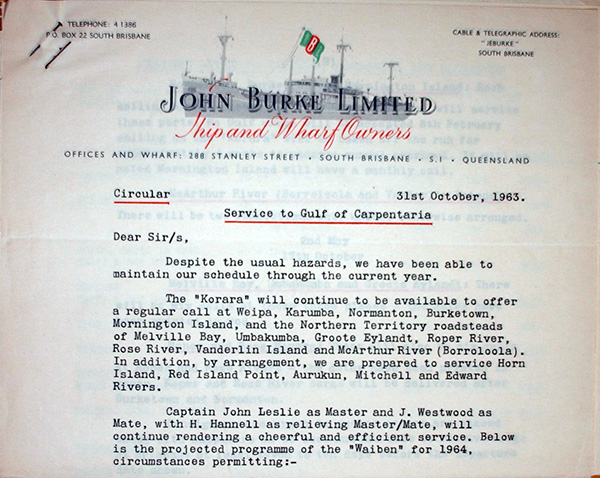 |
The first page of the Burke letter outlining the plans for 1964. (Hilda Maclean, 2015) |
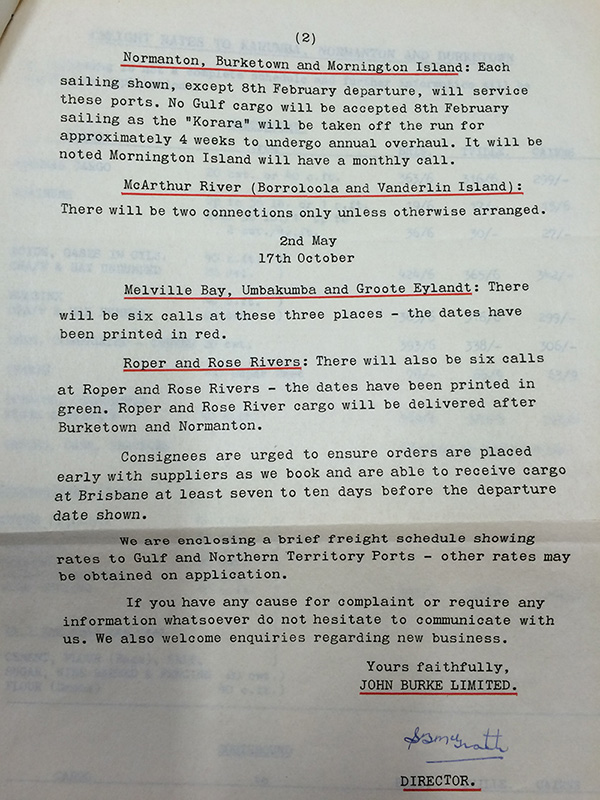 |
The second page of the Burke letter outlining the plans for 1964. (Martin Powley, 2015) |
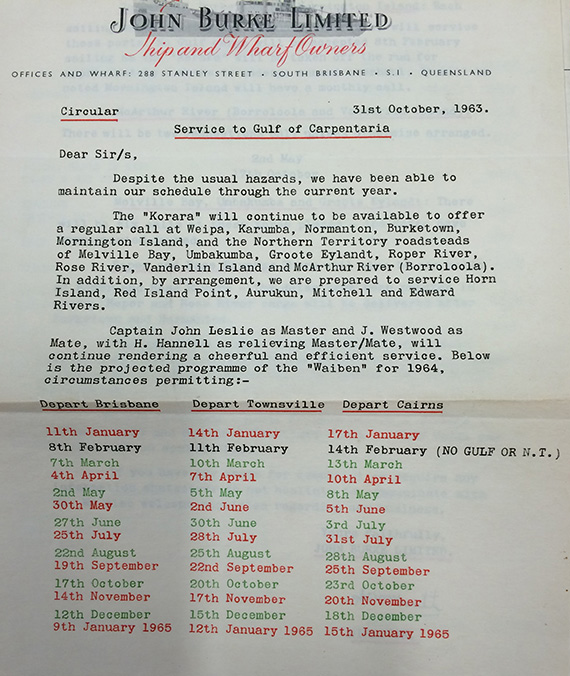 |
Planned services for 1964. The last two did not eventuate as the Waiben was sold. (Martin Powley, 2015) |
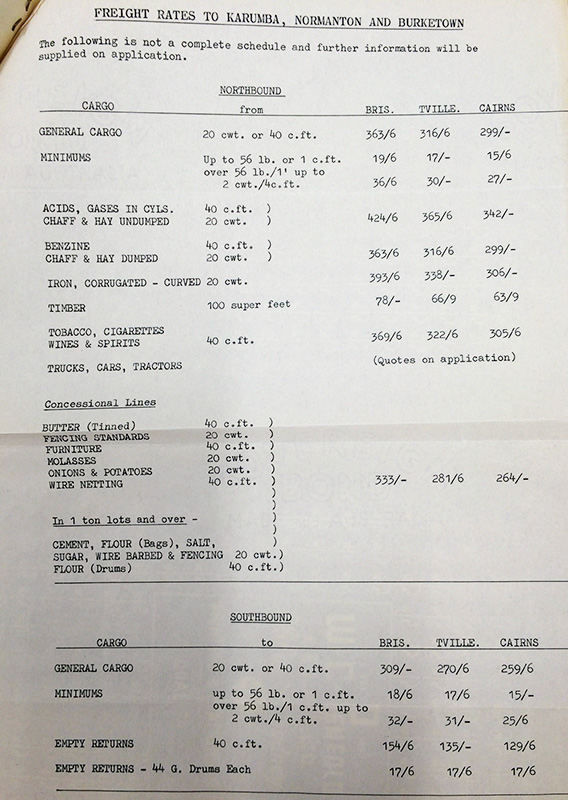 |
Freight costs for the Waiben 1964. (Martin Powley, 2015) |
